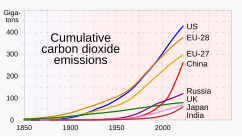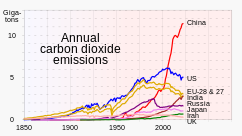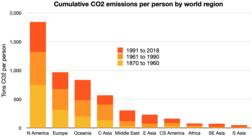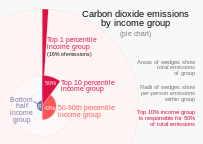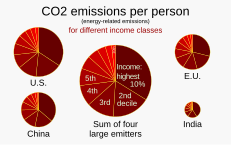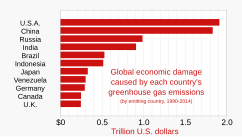Greenhouse gas emissions

Greenhouse gas (GHG) emissions from human activities intensify the greenhouse effect. This contributes to climate change. Carbon dioxide (CO2), from burning fossil fuels such as coal, oil, and natural gas, is the main cause of climate change. The largest annual emissions are from China followed by the United States. The United States has higher emissions per capita. The main producers fueling the emissions globally are large oil and gas companies. Emissions from human activities have increased atmospheric carbon dioxide by about 50% over pre-industrial levels. The growing levels of emissions have varied, but have been consistent among all greenhouse gases. Emissions in the 2010s averaged 56 billion tons a year, higher than any decade before.[2] Total cumulative emissions from 1870 to 2022 were 703 GtC (2575 GtCO2), of which 484±20 GtC (1773±73 GtCO2) from fossil fuels and industry, and 219±60 GtC (802±220 GtCO2) from land use change. Land-use change, such as deforestation, caused about 31% of cumulative emissions over 1870–2022, coal 32%, oil 24%, and gas 10%.[3][4]
Carbon dioxide is the main greenhouse gas resulting from human activities. It accounts for more than half of warming. Methane (CH4) emissions have almost the same short-term impact.[5] Nitrous oxide (N2O) and fluorinated gases (F-gases) play a lesser role in comparison. Emissions of carbon dioxide, methane and nitrous oxide in 2023 were all higher than ever before.[6]
Electricity generation, heat and transport are major emitters; overall energy is responsible for around 73% of emissions.[7] Deforestation and other changes in land use also emit carbon dioxide and methane. The largest source of anthropogenic methane emissions is agriculture, closely followed by gas venting and fugitive emissions from the fossil-fuel industry. The largest agricultural methane source is livestock. Agricultural soils emit nitrous oxide partly due to fertilizers. Similarly, fluorinated gases from refrigerants play an outsized role in total human emissions.
The current CO2-equivalent emission rates averaging 6.6 tonnes per person per year,[8] are well over twice the estimated rate 2.3 tons[9][10] required to stay within the 2030 Paris Agreement increase of 1.5 °C (2.7 °F) over pre-industrial levels.[11] Annual per capita emissions in the industrialized countries are typically as much as ten times the average in developing countries.[12]
The carbon footprint (or greenhouse gas footprint) serves as an indicator to compare the amount of greenhouse gases emitted over the entire life cycle from the production of a good or service along the supply chain to its final consumption.[13][14] Carbon accounting (or greenhouse gas accounting) is a framework of methods to measure and track how much greenhouse gas an organization emits.[15]
Relevance for greenhouse effect and global warming
[edit]The greenhouse effect occurs when greenhouse gases in a planet's atmosphere insulate the planet from losing heat to space, raising its surface temperature. Surface heating can happen from an internal heat source (as in the case of Jupiter) or come from an external source, such as its host star. In the case of Earth, the Sun emits shortwave radiation (sunlight) that passes through greenhouse gases to heat the Earth's surface. In response, the Earth's surface emits longwave radiation that is mostly absorbed by greenhouse gases. The absorption of longwave radiation prevents it from reaching space, reducing the rate at which the Earth can cool off.
Without the greenhouse effect, the Earth's average surface temperature would be as cold as −18 °C (−0.4 °F).[16][17] This is of course much less than the 20th century average of about 14 °C (57 °F).[18][19] In addition to naturally present greenhouse gases, burning of fossil fuels has increased amounts of carbon dioxide and methane in the atmosphere.[20][21] As a result, global warming of about 1.2 °C (2.2 °F) has occurred since the Industrial Revolution,[22] with the global average surface temperature increasing at a rate of 0.18 °C (0.32 °F) per decade since 1981.[23]Overview of main sources
[edit]
Relevant greenhouse gases
[edit]The major anthropogenic (human origin) sources of greenhouse gases are carbon dioxide (CO2), nitrous oxide (N
2O), methane and three groups of fluorinated gases (sulfur hexafluoride (SF
6), hydrofluorocarbons (HFCs) and perfluorocarbons (PFCs, sulphur hexafluoride (SF6), and nitrogen trifluoride (NF3)).[25] Though the greenhouse effect is heavily driven by water vapor,[26] human emissions of water vapor are not a significant contributor to warming.
Although CFCs are greenhouse gases, they are regulated by the Montreal Protocol which was motivated by CFCs' contribution to ozone depletion rather than by their contribution to global warming. Ozone depletion has only a minor role in greenhouse warming, though the two processes are sometimes confused in the media. In 2016, negotiators from over 170 nations meeting at the summit of the United Nations Environment Programme reached a legally binding accord to phase out hydrofluorocarbons (HFCs) in the Kigali Amendment to the Montreal Protocol.[27][28][29] The use of CFC-12 (except some essential uses) has been phased out due to its ozone depleting properties.[30] The phasing-out of less active HCFC-compounds will be completed in 2030.[31]
Human activities
[edit]
Starting about 1750, industrial activity powered by fossil fuels began to significantly increase the concentration of carbon dioxide and other greenhouse gases. Emissions have grown rapidly since about 1950 with ongoing expansions in global population and economic activity following World War II. As of 2021, measured atmospheric concentrations of carbon dioxide were almost 50% higher than pre-industrial levels.[32][33]
The main sources of greenhouse gases due to human activity (also called carbon sources) are:
- Burning fossil fuels: Burning oil, coal and gas is estimated to have emitted 37.4 billion tonnes of CO2-eq in 2023.[34] The largest single source is coal-fired power stations, with 20% of greenhouse gases (GHG) as of 2021.[35]
- Land use change (mainly deforestation in the tropics) accounts for about a quarter of total anthropogenic GHG emissions.[36]
- Livestock enteric fermentation and manure management,[37] paddy rice farming, land use and wetland changes, human-made lakes,[38] pipeline losses, and covered vented landfill emissions leading to higher methane atmospheric concentrations. Many of the newer style fully vented septic systems that enhance and target the fermentation process also are sources of atmospheric methane.
- Use of chlorofluorocarbons (CFCs) in refrigeration systems, and use of CFCs and halons in fire suppression systems and manufacturing processes.
- Agricultural soils emit nitrous oxide (N2O) partly due to application of fertilizers.[39]
- The largest source of anthropogenic methane emissions is agriculture, closely followed by gas venting and fugitive emissions from the fossil-fuel industry.[40][41] The largest agricultural methane source is livestock. Cattle (raised for both beef and milk, as well as for inedible outputs like manure and draft power) are the animal species responsible for the most emissions, representing about 65% of the livestock sector's emissions.[42]
Global estimates
[edit]This section needs to be updated. (April 2024) |
Global greenhouse gas emissions are about 50 Gt per year[24] and for 2019 have been estimated at 57 Gt CO2 eq including 5 Gt due to land use change.[43] In 2019, approximately 34% [20 GtCO2-eq] of total net anthropogenic GHG emissions came from the energy supply sector, 24% [14 GtCO2-eq] from industry, 22% [13 GtCO2-eq]from agriculture, forestry and other land use (AFOLU), 15% [8.7 GtCO2-eq] from transport and 6% [3.3 GtCO2-eq] from buildings.[44]
Global carbon dioxide emissions by country in 2023:
The current CO2-equivalent emission rates averaging 6.6 tonnes per person per year,[8] are well over twice the estimated rate 2.3 tons[9][10] required to stay within the 2030 Paris Agreement increase of 1.5 °C (2.7 °F) over pre-industrial levels.[11]
While cities are sometimes considered to be disproportionate contributors to emissions, per-capita emissions tend to be lower for cities than the averages in their countries.[45]
A 2017 survey of corporations responsible for global emissions found that 100 companies were responsible for 71% of global direct and indirect emissions, and that state-owned companies were responsible for 59% of their emissions.[46][47]
China is, by a significant margin, Asia's and the world's largest emitter: it emits nearly 10 billion tonnes each year, more than one-quarter of global emissions.[48] Other countries with fast growing emissions are South Korea, Iran, and Australia (which apart from the oil rich Persian Gulf states, now has the highest per capita emission rate in the world). On the other hand, annual per capita emissions of the EU-15 and the US are gradually decreasing over time.[49] Emissions in Russia and Ukraine have decreased fastest since 1990 due to economic restructuring in these countries.[50]
2015 was the first year to see both total global economic growth and a reduction of carbon emissions.[51]
High income countries compared to low income countries
[edit]
Annual per capita emissions in the industrialized countries are typically as much as ten times the average in developing countries.[12]: 144 Due to China's fast economic development, its annual per capita emissions are quickly approaching the levels of those in the Annex I group of the Kyoto Protocol (i.e., the developed countries excluding the US).[49]
Africa and South America are both fairly small emitters, accounting for 3-4% of global emissions each. Both have emissions almost equal to international aviation and shipping.[48]
Calculations and reporting
[edit]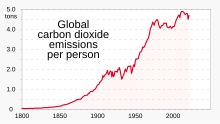
Variables
[edit]There are several ways of measuring greenhouse gas emissions. Some variables that have been reported include:[54]
- Definition of measurement boundaries: Emissions can be attributed geographically, to the area where they were emitted (the territory principle) or by the activity principle to the territory that produced the emissions. These two principles result in different totals when measuring, for example, electricity importation from one country to another, or emissions at an international airport.
- Time horizon of different gases: The contribution of given greenhouse gas is reported as a CO2 equivalent. The calculation to determine this takes into account how long that gas remains in the atmosphere. This is not always known accurately[clarification needed] and calculations must be regularly updated to reflect new information.
- The measurement protocol itself: This may be via direct measurement or estimation. The four main methods are the emission factor-based method, mass balance method, predictive emissions monitoring systems, and continuous emissions monitoring systems. These methods differ in accuracy, cost, and usability. Public information from space-based measurements of carbon dioxide by Climate Trace is expected to reveal individual large plants before the 2021 United Nations Climate Change Conference.[55]
These measures are sometimes used by countries to assert various policy/ethical positions on climate change.[56]: 94 The use of different measures leads to a lack of comparability, which is problematic when monitoring progress towards targets. There are arguments for the adoption of a common measurement tool, or at least the development of communication between different tools.[54]
Reporting
[edit]Emissions may be tracked over long time periods, known as historical or cumulative emissions measurements. Cumulative emissions provide some indicators of what is responsible for greenhouse gas atmospheric concentration build-up.[57]: 199
National accounts balance
[edit]The national accounts balance tracks emissions based on the difference between a country's exports and imports. For many richer nations, the balance is negative because more goods are imported than they are exported. This result is mostly due to the fact that it is cheaper to produce goods outside of developed countries, leading developed countries to become increasingly dependent on services and not goods. A positive account balance would mean that more production was occurring within a country, so more operational factories would increase carbon emission levels.[58]
Emissions may also be measured across shorter time periods. Emissions changes may, for example, be measured against the base year of 1990. 1990 was used in the United Nations Framework Convention on Climate Change (UNFCCC) as the base year for emissions, and is also used in the Kyoto Protocol (some gases are also measured from the year 1995).[12]: 146, 149 A country's emissions may also be reported as a proportion of global emissions for a particular year.
Another measurement is of per capita emissions. This divides a country's total annual emissions by its mid-year population.[59]: 370 Per capita emissions may be based on historical or annual emissions.[56]: 106–107
Embedded emissions
[edit]One way of attributing greenhouse gas emissions is to measure the embedded emissions (also referred to as "embodied emissions") of goods that are being consumed. Emissions are usually measured according to production, rather than consumption.[60] For example, in the main international treaty on climate change (the UNFCCC), countries report on emissions produced within their borders, e.g., the emissions produced from burning fossil fuels.[61]: 179 [62]: 1 Under a production-based accounting of emissions, embedded emissions on imported goods are attributed to the exporting, rather than the importing, country. Under a consumption-based accounting of emissions, embedded emissions on imported goods are attributed to the importing country, rather than the exporting, country.
A substantial proportion of CO2 emissions is traded internationally. The net effect of trade was to export emissions from China and other emerging markets to consumers in the US, Japan, and Western Europe.[62]: 4
Carbon footprint
[edit]Emission intensity
[edit]Emission intensity is a ratio between greenhouse gas emissions and another metric, e.g., gross domestic product (GDP) or energy use. The terms "carbon intensity" and "emissions intensity" are also sometimes used.[63] Emission intensities may be calculated using market exchange rates (MER) or purchasing power parity (PPP).[56]: 96 Calculations based on MER show large differences in intensities between developed and developing countries, whereas calculations based on PPP show smaller differences.
Example tools and websites
[edit]Carbon accounting (or greenhouse gas accounting) is a framework of methods to measure and track how much greenhouse gas an organization emits.[15]
Climate TRACE
[edit]Historical trends
[edit]Cumulative and historical emissions
[edit]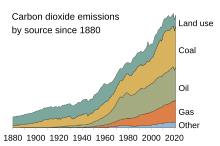
Cumulative anthropogenic (i.e., human-emitted) emissions of CO2 from fossil fuel use are a major cause of global warming,[72] and give some indication of which countries have contributed most to human-induced climate change. In particular, CO2 stays in the atmosphere for at least 150 years and up to 1000 years,[73] whilst methane disappears within a decade or so,[74] and nitrous oxides last about 100 years.[75] The graph gives some indication of which regions have contributed most to human-induced climate change.[76][77]: 15 When these numbers are calculated per capita cumulative emissions based on then-current population the situation is shown even more clearly. The ratio in per capita emissions between industrialized countries and developing countries was estimated at more than 10 to 1.
Non-OECD countries accounted for 42% of cumulative energy-related CO2 emissions between 1890 and 2007.[61]: 179–80 Over this time period, the US accounted for 28% of emissions; the EU, 23%; Japan, 4%; other OECD countries 5%; Russia, 11%; China, 9%; India, 3%; and the rest of the world, 18%.[61]: 179–80 The European Commission adopted a set of legislative proposals targeting a reduction of the CO2 emissions by 55% by 2030.
Overall, developed countries accounted for 83.8% of industrial CO2 emissions over this time period, and 67.8% of total CO2 emissions. Developing countries accounted for industrial CO2 emissions of 16.2% over this time period, and 32.2% of total CO2 emissions.
However, what becomes clear when we look at emissions across the world today is that the countries with the highest emissions over history are not always the biggest emitters today. For example, in 2017, the UK accounted for just 1% of global emissions.[48]
In comparison, humans have emitted more greenhouse gases than the Chicxulub meteorite impact event which caused the extinction of the dinosaurs.[78]
Transport, together with electricity generation, is the major source of greenhouse gas emissions in the EU. Greenhouse gas emissions from the transportation sector continue to rise, in contrast to power generation and nearly all other sectors. Since 1990, transportation emissions have increased by 30%. The transportation sector accounts for around 70% of these emissions. The majority of these emissions are caused by passenger vehicles and vans. Road travel is the first major source of greenhouse gas emissions from transportation, followed by aircraft and maritime.[79][80] Waterborne transportation is still the least carbon-intensive mode of transportation on average, and it is an essential link in sustainable multimodal freight supply chains.[81]
Buildings, like industry, are directly responsible for around one-fifth of greenhouse gas emissions, primarily from space heating and hot water consumption. When combined with power consumption within buildings, this figure climbs to more than one-third.[82][83][84]
Within the EU, the agricultural sector presently accounts for roughly 10% of total greenhouse gas emissions, with methane from livestock accounting for slightly more than half of 10%.[85]
Estimates of total CO2 emissions do include biotic carbon emissions, mainly from deforestation.[56]: 94 Including biotic emissions brings about the same controversy mentioned earlier regarding carbon sinks and land-use change.[56]: 93–94 The actual calculation of net emissions is very complex, and is affected by how carbon sinks are allocated between regions and the dynamics of the climate system.
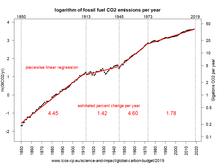
The graphic shows the logarithm of 1850–2019 fossil fuel CO2 emissions;[86] natural log on left, actual value of Gigatons per year on right. Although emissions increased during the 170-year period by about 3% per year overall, intervals of distinctly different growth rates (broken at 1913, 1945, and 1973) can be detected. The regression lines suggest that emissions can rapidly shift from one growth regime to another and then persist for long periods of time. The most recent drop in emissions growth – by almost 3 percentage points – was at about the time of the 1970s energy crisis. Percent changes per year were estimated by piecewise linear regression on the log data and are shown on the plot; the data are from The Integrated Carbon Observation system.[87]
Changes since a particular base year
[edit]The sharp acceleration in CO2 emissions since 2000 to more than a 3% increase per year (more than 2 ppm per year) from 1.1% per year during the 1990s is attributable to the lapse of formerly declining trends in carbon intensity of both developing and developed nations. China was responsible for most of global growth in emissions during this period. Localised plummeting emissions associated with the collapse of the Soviet Union have been followed by slow emissions growth in this region due to more efficient energy use, made necessary by the increasing proportion of it that is exported.[88] In comparison, methane has not increased appreciably, and N
2O by 0.25% y−1.
Using different base years for measuring emissions has an effect on estimates of national contributions to global warming.[77]: 17–18 [89] This can be calculated by dividing a country's highest contribution to global warming starting from a particular base year, by that country's minimum contribution to global warming starting from a particular base year. Choosing between base years of 1750, 1900, 1950, and 1990 has a significant effect for most countries.[77]: 17–18 Within the G8 group of countries, it is most significant for the UK, France and Germany. These countries have a long history of CO2 emissions (see the section on Cumulative and historical emissions).
Data from Global Carbon Project
[edit]
The Global Carbon Project continuously releases data about CO2 emissions, budget and concentration.
| Year | Fossil fuels
and industry (excluding cement carbonation) Gt C |
Land use
change Gt C |
Total
Gt C |
Total
Gt CO2 |
|---|---|---|---|---|
| 2010 | 9.106 | 1.32 | 10.43 | 38.0 |
| 2011 | 9.412 | 1.35 | 10.76 | 39.2 |
| 2012 | 9.554 | 1.32 | 10.87 | 39.6 |
| 2013 | 9.640 | 1.26 | 10.9 | 39.7 |
| 2014 | 9.710 | 1.34 | 11.05 | 40.2 |
| 2015 | 9.704 | 1.47 | 11.17 | 40.7 |
| 2016 | 9.695 | 1.24 | 10.93 | 39.8 |
| 2017 | 9.852 | 1.18 | 11.03 | 40.2 |
| 2018 | 10.051 | 1.14 | 11.19 | 40.7 |
| 2019 | 10.120 | 1.24 | 11.36 | 41.3 |
| 2020 | 9.624 | 1.11 | 10.73 | 39.1 |
| 2021 | 10.132 | 1.08 | 11.21 | 40.8 |
| 2022
(projection) |
10.2 | 1.08 | 11.28 | 41.3 |
Emissions by type of greenhouse gas
[edit]Distribution of global greenhouse gas emissions based on type of greenhouse gas, without land-use change, using 100 year global warming potential (data from 2020).
Total: 49.8 GtCO2e[92]: 5
2O nitrous oxide (6%)
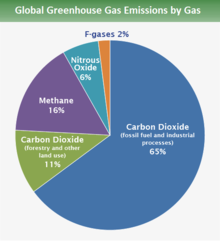
Carbon dioxide (CO2) is the dominant emitted greenhouse gas, while methane (CH4) emissions almost have the same short-term impact.[5] Nitrous oxide (N2O) and fluorinated gases (F-gases) play a lesser role in comparison.
Greenhouse gas emissions are measured in CO2 equivalents determined by their global warming potential (GWP), which depends on their lifetime in the atmosphere. Estimations largely depend on the ability of oceans and land sinks to absorb these gases. Short-lived climate pollutants (SLCPs) including methane, hydrofluorocarbons (HFCs), tropospheric ozone and black carbon persist in the atmosphere for a period ranging from days to 15 years; whereas carbon dioxide can remain in the atmosphere for millennia.[93] Reducing SLCP emissions can cut the ongoing rate of global warming by almost half and reduce the projected Arctic warming by two-thirds.[94]
Greenhouse gas emissions in 2019 were estimated at 57.4 GtCO2e, while CO2 emissions alone made up 42.5 Gt including land-use change (LUC).[95]
While mitigation measures for decarbonization are essential on the longer term, they could result in weak near-term warming because sources of carbon emissions often also co-emit air pollution. Hence, pairing measures that target carbon dioxide with measures targeting non-CO2 pollutants – short-lived climate pollutants, which have faster effects on the climate, is essential for climate goals.[96]
Carbon dioxide (CO2)
[edit]- Fossil fuel (use for energy generation, transport, heating and machinery in industrial plants): oil, gas and coal (89%) are the major driver of anthropogenic global warming with annual emissions of 35.6 GtCO2 in 2019.[97]: 20
- Cement production (burning of fossil fuels) (4%) is estimated at 1.42 GtCO2
- Land-use change (LUC) is the imbalance of deforestation and reforestation. Estimations are very uncertain at 4.5 GtCO2. Wildfires alone cause annual emissions of about 7 GtCO2[98][99]
- Non-energy use of fuels, carbon losses in coke ovens, and flaring in crude oil production.[97]
- Production of Hydrogen (using and transforming of Methane and Coal): Not yet estimated, emerging.
Methane (CH4)
[edit]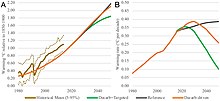
Methane has a high immediate impact with a 5-year global warming potential of up to 100.[5] Given this, the current 389 Mt of methane emissions[97]: 6 has about the same short-term global warming effect as CO2 emissions, with a risk to trigger irreversible changes in climate and ecosystems. For methane, a reduction of about 30% below current emission levels would lead to a stabilization in its atmospheric concentration.
- Fossil fuels (32%) (emissions due to losses during production and transport) account for most of the methane emissions including coal mining (12% of methane total), gas distribution and leakages (11%) as well as gas venting in oil production (9%).[97]: 6 [97]: 12
- Livestock (28%) with cattle (21%) as the dominant source, followed by buffalo (3%), sheep (2%), and goats (1.5%).[97]: 6, 23
- Human waste and wastewater (21%): When biomass waste in landfills and organic substances in domestic and industrial wastewater is decomposed by bacteria in anaerobic conditions, substantial amounts of methane are generated.[97]: 12
- Rice cultivation (10%) on flooded rice fields is another agricultural source, where anaerobic decomposition of organic material produces methane.[97]: 12
Nitrous oxide (N
2O)
[edit]N2O has a high GWP and significant Ozone Depleting Potential. It is estimated that the global warming potential of N2O over 100 years is 265 times greater than CO2.[100] For N2O, a reduction of more than 50% would be required for a stabilization.
Most emissions (56%) of nitrous oxide comes from agriculture, especially meat production: cattle (droppings on pasture), fertilizers, animal manure.[97]: 12 Further contributions come from combustion of fossil fuels (18%) and biofuels[101] as well as industrial production of adipic acid and nitric acid.
F-gases
[edit]Fluorinated gases include hydrofluorocarbons (HFC), perfluorocarbons (PFC), sulfur hexafluoride (SF6), and nitrogen trifluoride (NF3). They are used by switchgear in the power sector, semiconductor manufacture, aluminum production and a largely unknown source of SF6.[97]: 38 Continued phase down of manufacture and use of HFCs under the Kigali Amendment to the Montreal Protocol will help reduce HFC emissions and concurrently improve the energy efficiency of appliances that use HFCs like air conditioners, freezers and other refrigeration devices.
Hydrogen
[edit]Hydrogen leakages contribute to indirect global warming.[102] When hydrogen is oxidized in the atmosphere, the result is an increase in concentrations of greenhouse gases in both the troposphere and the stratosphere.[103] Hydrogen can leak from hydrogen production facilities as well as any infrastructure in which hydrogen is transported, stored, or consumed.[104]
Black carbon
[edit]Black carbon is formed through the incomplete combustion of fossil fuels, biofuel, and biomass. It is not a greenhouse gas but a climate forcing agent. Black carbon can absorb sunlight and reduce albedo when deposited on snow and ice. Indirect heating can be caused by the interaction with clouds.[105] Black carbon stays in the atmosphere for only several days to weeks.[106] Emissions may be mitigated by upgrading coke ovens, installing particulate filters on diesel-based engines, reducing routine flaring, and minimizing open burning of biomass.
Emissions by sector
[edit]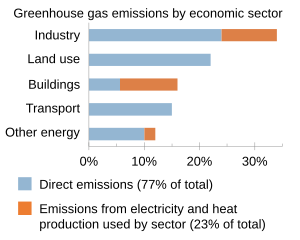
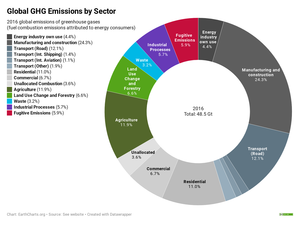
Global greenhouse gas emissions can be attributed to different sectors of the economy. This provides a picture of the varying contributions of different types of economic activity to climate change, and helps in understanding the changes required to mitigate climate change.
Greenhouse gas emissions can be divided into those that arise from the combustion of fuels to produce energy, and those generated by other processes. Around two thirds of greenhouse gas emissions arise from the combustion of fuels.[108]
Energy may be produced at the point of consumption, or by a generator for consumption by others. Thus emissions arising from energy production may be categorized according to where they are emitted, or where the resulting energy is consumed. If emissions are attributed at the point of production, then electricity generators contribute about 25% of global greenhouse gas emissions.[109] If these emissions are attributed to the final consumer then 24% of total emissions arise from manufacturing and construction, 17% from transportation, 11% from domestic consumers, and 7% from commercial consumers.[110] Around 4% of emissions arise from the energy consumed by the energy and fuel industry itself.
The remaining third of emissions arise from processes other than energy production. 12% of total emissions arise from agriculture, 7% from land use change and forestry, 6% from industrial processes, and 3% from waste.[108]
Electricity generation
[edit]
Coal-fired power stations are the single largest emitter, with over 20% of global greenhouse gas emissions in 2018.[112] Although much less polluting than coal plants, natural gas-fired power plants are also major emitters,[113] taking electricity generation as a whole over 25% in 2018.[114] Notably, just 5% of the world's power plants account for almost three-quarters of carbon emissions from electricity generation, based on an inventory of more than 29,000 fossil-fuel power plants across 221 countries.[115] In the 2022 IPCC report, it is noted that providing modern energy services universally would only increase greenhouse gas emissions by a few percent at most. This slight increase means that the additional energy demand that comes from supporting decent living standards for all would be far lower than current average energy consumption.[116]
In March 2024, the International Energy Agency (IEA) reported that in 2023, global CO2 emissions from energy sources increased by 1.1%, rising by 410 million tonnes to a record 37.4 billion tonnes, primarily due to coal. Drought-related decreases in hydropower contributed to a 170 million tonne rise in emissions, which would have otherwise led to a decrease in the electricity sector's emissions.[117] The implementation of clean energy technologies like solar, wind, nuclear, heat pumps, and electric vehicles since 2019 has significantly tempered emissions growth, which would have been threefold without these technologies.[117]
Agriculture, forestry and land use
[edit]Agriculture
[edit]The amount of greenhouse gas emissions from agriculture is significant: The agriculture, forestry and land use sectors contribute between 13% and 21% of global greenhouse gas emissions.[118] Emissions come from direct greenhouse gas emissions (for example from rice production and livestock farming).[119] And from indirect emissions. With regards to direct emissions, nitrous oxide and methane makeup over half of total greenhouse gas emissions from agriculture.[120] Indirect emissions on the other hand come from the conversion of non-agricultural land such as forests into agricultural land.[121][122] Furthermore, there is also fossil fuel consumption for transport and fertilizer production. For example, the manufacture and use of nitrogen fertilizer contributes around 5% of all global greenhouse gas emissions.[123] Livestock farming is a major source of greenhouse gas emissions.[124] At the same time, livestock farming is affected by climate change.
Farm animals' digestive systems can be put into two categories: monogastric and ruminant. Ruminant cattle for beef and dairy rank high in greenhouse gas emissions. In comparison, monogastric, or pigs and poultry-related foods, are lower. The consumption of the monogastric types may yield less emissions. Monogastric animals have a higher feed-conversion efficiency and also do not produce as much methane.[125] Non-ruminant livestock, such as poultry, emit far fewer greenhouse gases.[126]
There are many strategies to reduce greenhouse gas emissions from agriculture (this is one of the goals of climate-smart agriculture). Mitigation measures in the food system can be divided into four categories. These are demand-side changes, ecosystem protections, mitigation on farms, and mitigation in supply chains. On the demand side, limiting food waste is an effective way to reduce food emissions. Changes to a diet less reliant on animal products such as plant-based diets are also effective.[127]: XXV This could include milk substitutes and meat alternatives. Several methods are also under investigation to reduce the greenhouse gas emissions from livestock farming. These include genetic selection,[128][129] introduction of methanotrophic bacteria into the rumen,[130][131] vaccines, feeds,[132] diet modification and grazing management.[133][134][135]Deforestation
[edit]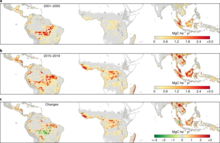
Deforestation is a major source of greenhouse gas emissions. A study shows annual carbon emissions (or carbon loss) from tropical deforestation have doubled during the last two decades and continue to increase. (0.97 ±0.16 PgC per year in 2001–2005 to 1.99 ±0.13 PgC per year in 2015–2019)[137][136]
Land-use change
[edit]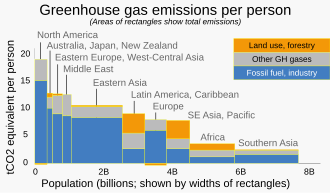
Land-use change, e.g., the clearing of forests for agricultural use, can affect the concentration of greenhouse gases in the atmosphere by altering how much carbon flows out of the atmosphere into carbon sinks.[139] Accounting for land-use change can be understood as an attempt to measure "net" emissions, i.e., gross emissions from all sources minus the removal of emissions from the atmosphere by carbon sinks.[56]: 92–93
There are substantial uncertainties in the measurement of net carbon emissions.[140] Additionally, there is controversy over how carbon sinks should be allocated between different regions and over time.[56]: 93 For instance, concentrating on more recent changes in carbon sinks is likely to favour those regions that have deforested earlier, e.g., Europe.
In 1997, human-caused Indonesian peat fires were estimated to have released between 13% and 40% of the average annual global carbon emissions caused by the burning of fossil fuels.[141][142][143]
Transport of people and goods
[edit]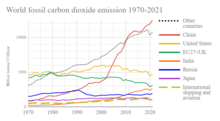
Transportation accounts for 15% of emissions worldwide.[144] Over a quarter of global transport CO2 emissions are from road freight,[145] so many countries are further restricting truck CO2 emissions to help limit climate change.[146]
Maritime transport accounts for 3.5% to 4% of all greenhouse gas emissions, primarily carbon dioxide.[147][148] In 2022, the shipping industry's 3% of global greenhouse gas emissions made it "the sixth largest greenhouse gas emitter worldwide, ranking between Japan and Germany."[149][150][151]
Aviation
[edit]Jet airliners contribute to climate change by emitting carbon dioxide (CO2), nitrogen oxides, contrails and particulates.In 2018, global commercial operations generated 2.4% of all CO2 emissions.[152]
In 2020, approximately 3.5% of the overall human impacts on climate are from the aviation sector. The impact of the sector on climate in the last 20 years had doubled, but the part of the contribution of the sector in comparison to other sectors did not change because other sectors grew as well.[153]
Some representative figures for CO2 average direct emissions (not accounting for high-altitude radiative effects) of airliners expressed as CO2 and CO2 equivalent per passenger kilometer:[154]
- Domestic, short distance, less than 463 km (288 mi): 257 g/km CO2 or 259 g/km (14.7 oz/mile) CO2e
- Long-distance flights: 113 g/km CO2 or 114 g/km (6.5 oz/mile) CO2e
Buildings and construction
[edit]In 2018, manufacturing construction materials and maintaining buildings accounted for 39% of carbon dioxide emissions from energy and process-related emissions. Manufacture of glass, cement, and steel accounted for 11% of energy and process-related emissions.[155] Because building construction is a significant investment, more than two-thirds of buildings in existence will still exist in 2050. Retrofitting existing buildings to become more efficient will be necessary to meet the targets of the Paris Agreement; it will be insufficient to only apply low-emission standards to new construction.[156] Buildings that produce as much energy as they consume are called zero-energy buildings, while buildings that produce more than they consume are energy-plus. Low-energy buildings are designed to be highly efficient with low total energy consumption and carbon emissions—a popular type is the passive house.[155]
The construction industry has seen marked advances in building performance and energy efficiency over recent decades.[157] Green building practices that avoid emissions or capture the carbon already present in the environment, allow for reduced footprint of the construction industry, for example, use of hempcrete, cellulose fiber insulation, and landscaping.[158]
In 2019, the building sector was responsible for 12 GtCO2-eq emissions. More than 95% of these emissions were carbon, and the remaining 5% were CH4, N2O, and halocarbon.[159]
The largest contributor to building sector emissions (49% of total) is the production of electricity for use in buildings.[160]
Of global building sector GHG emissions, 28% are produced during the manufacturing process of building materials such as steel, cement (a key component of concrete),[161] and glass.[160] The conventional process inherently related to the production of steel and cement results in large amounts of CO2 emitted. For example, the production of steel in 2018 was responsible for 7 to 9% of the global CO2 emissions.[162]
The remaining 23% of global building sector GHG emissions are produced directly on site during building operations.[160]
Embodied carbon emissions in construction sector
[edit]Embodied carbon emissions, or upfront carbon emissions (UCE), are the result of creating and maintaining the materials that form a building.[163] As of 2018, "Embodied carbon is responsible 11% of global greenhouse gas emissions and 28% of global building sector emissions ... Embodied carbon will be responsible for almost half of total new construction emissions between now and 2050."[164]
GHG emissions which are produced during the mining, processing, manufacturing, transportation and installation of building materials are referred to as the embodied carbon of a material.[165] The embodied carbon of a construction project can be reduced by using low-carbon materials for building structures and finishes, reducing demolition, and reusing buildings and construction materials whenever possible.[160]
Industrial processes
[edit]As of 2020[update] Secunda CTL is the world's largest single emitter, at 56.5 million tonnes CO2 a year.[166]
Mining
[edit]Flaring and venting of natural gas in oil wells is a significant source of greenhouse gas emissions. Its contribution to greenhouse gases has declined by three-quarters in absolute terms since a peak in the 1970s of approximately 110 million metric tons/year, and in 2004 accounted for about 1/2 of one percent of all anthropogenic carbon dioxide emissions.[167]
The World Bank estimates that 134 billion cubic meters of natural gas are flared or vented annually (2010 datum), an amount equivalent to the combined annual gas consumption of Germany and France or enough to supply the entire world with gas for 16 days. This flaring is highly concentrated: 10 countries account for 70% of emissions, and twenty for 85%.[168]
Steel and aluminum
[edit]Steel and aluminum are key economic sectors where CO2 is produced. According to a 2013 study, "in 2004, the steel industry along emits about 590M tons of CO2, which accounts for 5.2% of the global anthropogenic GHG emissions. CO2 emitted from steel production primarily comes from energy consumption of fossil fuel as well as the use of limestone to purify iron oxides."[169]
Plastics
[edit]Plastics are produced mainly from fossil fuels. It was estimated that between 3% and 4% of global GHG emissions are associated with plastics' life cycles.[170] The EPA estimates[171] as many as five mass units of carbon dioxide are emitted for each mass unit of polyethylene terephthalate (PET) produced—the type of plastic most commonly used for beverage bottles,[172] the transportation produce greenhouse gases also.[173] Plastic waste emits carbon dioxide when it degrades. In 2018 research claimed that some of the most common plastics in the environment release the greenhouse gases methane and ethylene when exposed to sunlight in an amount that can affect the earth climate.[174][175]
Due to the lightness of plastic versus glass or metal, plastic may reduce energy consumption. For example, packaging beverages in PET plastic rather than glass or metal is estimated to save 52% in transportation energy, if the glass or metal package is single-use, of course.
In 2019 a new report "Plastic and Climate" was published. According to the report, the production and incineration of plastics will contribute in the equivalent of 850 million tonnes of carbon dioxide (CO2) to the atmosphere in 2019. With the current trend, annual life cycle greenhouse gas emissions of plastics will grow to 1.34 billion tonnes by 2030. By 2050, the life cycle emissions of plastics could reach 56 billion tonnes, as much as 14 percent of the Earth's remaining carbon budget.[176] The report says that only solutions which involve a reduction in consumption can solve the problem, while others like biodegradable plastic, ocean cleanup, using renewable energy in plastic industry can do little, and in some cases may even worsen it.[177]
Pulp and paper
[edit]The global print and paper industry accounts for about 1% of global carbon dioxide emissions.[178] Greenhouse gas emissions from the pulp and paper industry are generated from the combustion of fossil fuels required for raw material production and transportation, wastewater treatment facilities, purchased power, paper transportation, printed product transportation, disposal and recycling.
Various services
[edit]Digital services
[edit]In 2020, data centers (excluding cryptocurrency mining) and data transmission each used about 1% of world electricity.[179] The digital sector produces between 2% and 4% of global GHG emissions,[180] a large part of which is from chipmaking.[181] However the sector reduces emissions from other sectors which have a larger global share, such as transport of people,[182] and possibly buildings and industry.[183]
Mining for proof-of-work cryptocurrencies requires enormous amounts of electricity and consequently comes with a large carbon footprint.[184] Proof-of-work blockchains such as Bitcoin, Ethereum, Litecoin, and Monero were estimated to have added between 3 million and 15 million tonnes of carbon dioxide (CO2) to the atmosphere in the period from 1 January 2016 to 30 June 2017.[185] By the end of 2021, Bitcoin was estimated to produce 65.4 million tonnes of CO2, as much as Greece,[186] and consume between 91 and 177 terawatt-hours annually. Bitcoin is the least energy-efficient cryptocurrency, using 707.6 kilowatt-hours of electricity per transaction.[187][188][189]
A study in 2015 investigated the global electricity usage that can be ascribed to Communication Technology (CT) between 2010 and 2030. Electricity usage from CT was divided into four principle categories: (i) consumer devices, including personal computers, mobile phones, TVs and home entertainment systems; (ii) network infrastructure; (iii) data center computation and storage; and lastly (iv) production of the above categories. The study estimated for the worst-case scenario, that CT electricity usage could contribute up to 23% of the globally released greenhouse gas emissions in 2030.[190]
Health care
[edit]The healthcare sector produces 4.4–4.6% of global greenhouse gas emissions.[191]
Based on the 2013 life cycle emissions in the health care sector, it is estimated that the GHG emissions associated with US health care activities may cause an additional 123,000 to 381,000 DALYs annually.[192]
Water supply and sanitation
[edit]Tourism
[edit]According to UNEP, global tourism is a significant contributor to the increasing concentrations of greenhouse gases in the atmosphere.[195]
Emissions by other characteristics
[edit]The responsibility for anthropogenic climate change differs substantially among individuals, e.g. between groups or cohorts.
By type of energy source
[edit]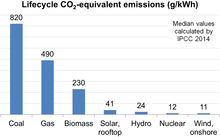
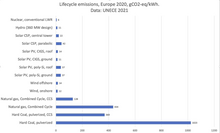
Greenhouse gas emissions are one of the environmental impacts of electricity generation. Measurement of life-cycle greenhouse gas emissions involves calculating the global warming potential (GWP) of energy sources through life-cycle assessment. These are usually sources of only electrical energy but sometimes sources of heat are evaluated.[197] The findings are presented in units of global warming potential per unit of electrical energy generated by that source. The scale uses the global warming potential unit, the carbon dioxide equivalent (CO2e), and the unit of electrical energy, the kilowatt hour (kWh). The goal of such assessments is to cover the full life of the source, from material and fuel mining through construction to operation and waste management.
In 2014, the Intergovernmental Panel on Climate Change harmonized the carbon dioxide equivalent (CO2e) findings of the major electricity generating sources in use worldwide. This was done by analyzing the findings of hundreds of individual scientific papers assessing each energy source.[198] Coal is by far the worst emitter, followed by natural gas, with solar, wind and nuclear all low-carbon. Hydropower, biomass, geothermal and ocean power may generally be low-carbon, but poor design or other factors could result in higher emissions from individual power stations.By socio-economic class and age
[edit]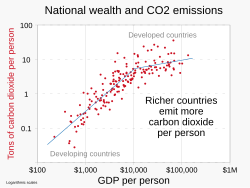
Fueled by the consumptive lifestyle of wealthy people, the wealthiest 5% of the global population has been responsible for 37% of the absolute increase in greenhouse gas emissions worldwide. It can be seen that there is a strong relationship between income and per capita carbon dioxide emissions.[48] Almost half of the increase in absolute global emissions has been caused by the richest 10% of the population.[202] In the newest report from the IPCC 2022, it states that the lifestyle consumptions of the poor and middle class in emerging economies produce approximately 5–50 times less the amount that the high class in already developed high-income countries.[203][204] Variations in regional, and national per capita emissions partly reflect different development stages, but they also vary widely at similar income levels. The 10% of households with the highest per capita emissions contribute a disproportionately large share of global household greenhouse gas emissions.[204]
Studies find that the most affluent citizens of the world are responsible for most environmental impacts, and robust action by them is necessary for prospects of moving towards safer environmental conditions.[205][206]
According to a 2020 report by Oxfam and the Stockholm Environment Institute,[207][208] the richest 1% of the global population have caused twice as much carbon emissions as the poorest 50% over the 25 years from 1990 to 2015.[209][210][211] This was, respectively, during that period, 15% of cumulative emissions compared to 7%.[212] The bottom half of the population is directly responsible for less than 20% of energy footprints and consume less than the top 5% in terms of trade-corrected energy. The largest disproportionality was identified to be in the domain of transport, where e.g. the top 10% consume 56% of vehicle fuel and conduct 70% of vehicle purchases.[213] However, wealthy individuals are also often shareholders and typically have more influence[214] and, especially in the case of billionaires, may also direct lobbying efforts, direct financial decisions, and/or control companies.
Based on a study in 32 developed countries, researchers found that "seniors in the United States and Australia have the highest per capita footprint, twice the Western average. The trend is mainly due to changes in expenditure patterns of seniors".[215]
Methods for reducing greenhouse gas emissions
[edit]Governments have taken action to reduce greenhouse gas emissions to mitigate climate change. Countries and regions listed in Annex I of the United Nations Framework Convention on Climate Change (UNFCCC) (i.e., the OECD and former planned economies of the Soviet Union) are required to submit periodic assessments to the UNFCCC of actions they are taking to address climate change.[216]: 3 Policies implemented by governments include for example national and regional targets to reduce emissions, promoting energy efficiency, and support for an energy transition.
Climate change mitigation (or decarbonisation) is action to limit the greenhouse gases in the atmosphere that cause climate change. Climate change mitigation actions include conserving energy and replacing fossil fuels with clean energy sources. Secondary mitigation strategies include changes to land use and removing carbon dioxide (CO2) from the atmosphere.[217][218] Current climate change mitigation policies are insufficient as they would still result in global warming of about 2.7 °C by 2100,[219] significantly above the 2015 Paris Agreement's[220] goal of limiting global warming to below 2 °C.[221][222]
Solar energy and wind power can replace fossil fuels at the lowest cost compared to other renewable energy options.[223] The availability of sunshine and wind is variable and can require electrical grid upgrades, such as using long-distance electricity transmission to group a range of power sources.[224] Energy storage can also be used to even out power output, and demand management can limit power use when power generation is low. Cleanly generated electricity can usually replace fossil fuels for powering transportation, heating buildings, and running industrial processes.[citation needed] Certain processes are more difficult to decarbonise, such as air travel and cement production. Carbon capture and storage (CCS) can be an option to reduce net emissions in these circumstances, although fossil fuel power plants with CCS technology is currently a high cost climate change mitigation strategy.[225]Projections for future emissions
[edit]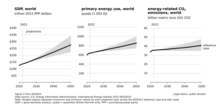
In October 2023, the US Energy Information Administration (EIA) released a series of projections out to 2050 based on current ascertainable policy interventions.[226][227][228] Unlike many integrated systems models in this field, emissions are allowed to float rather than be pinned to net‑zero in 2050. A sensitivity analysis varied key parameters, primarily future GDP growth (2.6% pa as reference, variously 1.8% and 3.4%) and secondarily technological learning rates, future crude oil prices, and similar exogenous inputs. The model results are far from encouraging. In no case did aggregate energy-related carbon emissions ever dip below 2022 levels (see figure 3 plot). The IEO2023 exploration provides a benchmark and suggests that far stronger action is needed.
The annual "Emissions Gap Report" by UNEP stated in 2022 that it was necessary to almost halve emissions. "To get on track for limiting global warming to 1.5°C, global annual GHG emissions must be reduced by 45 per cent compared with emissions projections under policies currently in place in just eight years, and they must continue to decline rapidly after 2030, to avoid exhausting the limited remaining atmospheric carbon budget."[229]: xvi The report commented that the world should focus on broad-based economy-wide transformations and not incremental change.[229]: xvi
In 2022, the Intergovernmental Panel on Climate Change (IPCC) released its Sixth Assessment Report on climate change. It warned that greenhouse gas emissions must peak before 2025 at the latest and decline 43% by 2030 to have a good chance of limiting global warming to 1.5 °C (2.7 °F).[230][231] Or in the words of Secretary-General of the United Nations António Guterres: "Main emitters must drastically cut emissions starting this year".[232]By country
[edit]List of countries
[edit]In 2019, China, the United States, India, the EU27+UK, Russia, and Japan - the world's largest CO2 emitters - together accounted for 51% of the population, 62.5% of global gross domestic product, 62% of total global fossil fuel consumption and emitted 67% of total global fossil CO2. Emissions from these five countries and the EU28 show different changes in 2019 compared to 2018: the largest relative increase is found for China (+3.4%), followed by India (+1.6%). On the contrary, the EU27+UK (-3.8%), the United States (-2.6%), Japan (-2.1%) and Russia (-0.8%) reduced their fossil CO2 emissions.[233]
| Country | Total emissions (Mton) |
Share (%) |
Per capita (ton) |
Per GDP (ton/k$) |
|---|---|---|---|---|
| Global Total | 38,016.57 | 100.00 | 4.93 | 0.29 |
| 11,535.20 | 30.34 | 8.12 | 0.51 | |
| 5,107.26 | 13.43 | 15.52 | 0.25 | |
| EU27+UK | 3,303.97 | 8.69 | 6.47 | 0.14 |
| 2,597.36 | 6.83 | 1.90 | 0.28 | |
| 1,792.02 | 4.71 | 12.45 | 0.45 | |
| 1,153.72 | 3.03 | 9.09 | 0.22 | |
| International Shipping | 730.26 | 1.92 | - | - |
| 702.60 | 1.85 | 8.52 | 0.16 | |
| 701.99 | 1.85 | 8.48 | 0.68 | |
| 651.87 | 1.71 | 12.70 | 0.30 | |
| International Aviation | 627.48 | 1.65 | - | - |
| 625.66 | 1.65 | 2.32 | 0.20 | |
| 614.61 | 1.62 | 18.00 | 0.38 | |
| 584.85 | 1.54 | 15.69 | 0.32 | |
| 494.86 | 1.30 | 8.52 | 0.68 | |
| 485.00 | 1.28 | 3.67 | 0.19 | |
| 478.15 | 1.26 | 2.25 | 0.15 | |
| 433.38 | 1.14 | 17.27 | 0.34 | |
| 415.78 | 1.09 | 5.01 | 0.18 | |
| 364.91 | 0.96 | 5.45 | 0.12 | |
| 331.56 | 0.87 | 5.60 | 0.13 | |
| 317.65 | 0.84 | 8.35 | 0.25 | |
| 314.74 | 0.83 | 4.81 | 0.10 | |
| 305.25 | 0.80 | 3.13 | 0.39 | |
| 277.36 | 0.73 | 14.92 | 0.57 | |
| 276.78 | 0.73 | 11.65 | 0.23 | |
| 275.06 | 0.72 | 3.97 | 0.21 | |
| 259.31 | 0.68 | 5.58 | 0.13 | |
| 255.37 | 0.67 | 2.52 | 0.22 | |
| 248.83 | 0.65 | 7.67 | 0.27 | |
| 223.63 | 0.59 | 1.09 | 0.22 | |
| 222.61 | 0.59 | 22.99 | 0.34 | |
| 199.41 | 0.52 | 4.42 | 0.20 | |
| 197.61 | 0.52 | 4.89 | 0.46 | |
| 196.40 | 0.52 | 4.48 | 0.36 | |
| 180.57 | 0.47 | 4.23 | 0.37 | |
| 156.41 | 0.41 | 9.13 | 0.16 | |
| 150.64 | 0.40 | 1.39 | 0.16 | |
| 110.16 | 0.29 | 0.66 | 0.14 | |
| 110.06 | 0.29 | 3.36 | 0.39 | |
| 106.53 | 0.28 | 38.82 | 0.41 | |
| 105.69 | 0.28 | 9.94 | 0.25 | |
| 104.41 | 0.27 | 9.03 | 0.18 | |
| 100.22 | 0.26 | 0.50 | 0.10 | |
| 98.95 | 0.26 | 23.29 | 0.47 | |
| 94.99 | 0.25 | 2.90 | 0.40 | |
| 92.78 | 0.24 | 18.55 | 0.67 | |
| 90.52 | 0.24 | 15.23 | 0.98 | |
| 89.89 | 0.24 | 4.90 | 0.20 | |
| 86.55 | 0.23 | 1.74 | 0.12 | |
| 78.63 | 0.21 | 4.04 | 0.14 | |
| 73.91 | 0.19 | 2.02 | 0.27 | |
| 72.36 | 0.19 | 8.25 | 0.14 | |
| 70.69 | 0.19 | 7.55 | 0.44 | |
| 68.33 | 0.18 | 7.96 | 0.18 | |
| 66.34 | 0.17 | 7.03 | 0.37 | |
| 65.57 | 0.17 | 5.89 | 0.20 | |
| 56.29 | 0.15 | 1.71 | 0.13 | |
| 53.37 | 0.14 | 9.09 | 0.10 | |
| 53.18 | 0.14 | 5.51 | 0.17 | |
| 52.05 | 0.14 | 7.92 | 0.51 | |
| 48.47 | 0.13 | 4.73 | 0.14 | |
| 48.31 | 0.13 | 0.89 | 0.17 | |
| 47.99 | 0.13 | 8.89 | 0.14 | |
| 44.75 | 0.12 | 4.45 | 0.08 | |
| 44.02 | 0.12 | 5.88 | 0.10 | |
| 43.41 | 0.11 | 7.81 | 0.16 | |
| 43.31 | 0.11 | 6.20 | 0.27 | |
| 42.17 | 0.11 | 1.64 | 0.36 | |
| 40.70 | 0.11 | 2.38 | 0.21 | |
| 39.37 | 0.10 | 4.57 | 0.07 | |
| 38.67 | 0.10 | 8.07 | 0.18 | |
| 36.55 | 0.10 | 7.54 | 0.09 | |
| 35.99 | 0.09 | 6.60 | 0.20 | |
| 35.98 | 0.09 | 3.59 | 0.25 | |
| 35.93 | 0.09 | 11.35 | 0.91 | |
| 35.44 | 0.09 | 21.64 | 0.48 | |
| 33.50 | 0.09 | 9.57 | 0.68 | |
| 32.74 | 0.09 | 23.81 | 0.90 | |
| 32.07 | 0.08 | 2.72 | 0.25 | |
| 31.12 | 0.08 | 5.39 | 0.09 | |
| 31.04 | 0.08 | 2.70 | 0.11 | |
| 29.16 | 0.08 | 1.58 | 1.20 | |
| 28.34 | 0.07 | 2.81 | 0.28 | |
| 27.57 | 0.07 | 1.31 | 0.10 | |
| 27.44 | 0.07 | 4.52 | 0.27 | |
| 27.28 | 0.07 | 2.48 | 0.14 | |
| 25.82 | 0.07 | 0.81 | 0.12 | |
| 24.51 | 0.06 | 2.15 | 0.24 | |
| 22.57 | 0.06 | 0.40 | 0.13 | |
| 21.20 | 0.06 | 1.21 | 0.15 | |
| 19.81 | 0.05 | 0.38 | 0.09 | |
| 19.12 | 0.05 | 4.62 | 0.16 | |
| 18.50 | 0.05 | 14.19 | 0.38 | |
| 18.25 | 0.05 | 0.17 | 0.07 | |
| 16.84 | 0.04 | 0.56 | 0.10 | |
| 16.49 | 0.04 | 1.00 | 0.23 | |
| 15.66 | 0.04 | 55.25 | 1.67 | |
| 15.37 | 0.04 | 7.38 | 0.19 | |
| 15.02 | 0.04 | 0.50 | 0.15 | |
| 13.77 | 0.04 | 4.81 | 0.13 | |
| 13.56 | 0.04 | 0.53 | 0.10 | |
| 13.47 | 0.04 | 3.45 | 0.24 | |
| 13.34 | 0.04 | 0.22 | 0.09 | |
| 11.92 | 0.03 | 1.92 | 0.35 | |
| 11.63 | 0.03 | 2.75 | 0.09 | |
| 11.00 | 0.03 | 0.30 | 0.13 | |
| 10.89 | 0.03 | 0.37 | 0.17 | |
| 10.86 | 0.03 | 0.63 | 0.26 | |
| 10.36 | 0.03 | 1.08 | 0.19 | |
| 10.10 | 0.03 | 0.40 | 0.11 | |
| 9.81 | 0.03 | 0.59 | 0.18 | |
| 9.74 | 0.03 | 16.31 | 0.14 | |
| 9.26 | 0.02 | 0.29 | 0.24 | |
| 9.23 | 0.02 | 2.29 | 0.27 | |
| 8.98 | 0.02 | 1.80 | 0.09 | |
| 8.92 | 0.02 | 4.28 | 0.26 | |
| 8.92 | 0.02 | 0.96 | 0.28 | |
| 8.47 | 0.02 | 1.21 | 0.09 | |
| 8.38 | 0.02 | 4.38 | 0.14 | |
| 8.15 | 0.02 | 0.69 | 0.21 | |
| 7.66 | 0.02 | 1.64 | 0.33 | |
| 7.50 | 0.02 | 0.41 | 0.12 | |
| 7.44 | 0.02 | 2.56 | 0.26 | |
| 7.41 | 0.02 | 6.19 | 0.21 | |
| 7.15 | 0.02 | 1.11 | 0.13 | |
| 7.04 | 0.02 | 2.96 | 0.17 | |
| 7.02 | 0.02 | 15.98 | 0.26 | |
| 6.78 | 0.02 | 0.96 | 0.12 | |
| 6.56 | 0.02 | 1.89 | 0.09 | |
| 5.92 | 0.02 | 2.02 | 0.15 | |
| 5.91 | 0.02 | 36.38 | 1.51 | |
| 5.86 | 0.02 | 0.92 | 0.17 | |
| 5.80 | 0.02 | 1.05 | 0.33 | |
| 5.66 | 0.01 | 1.93 | 0.14 | |
| 5.34 | 0.01 | 0.12 | 0.06 | |
| 4.40 | 0.01 | 1.67 | 0.18 | |
| 4.33 | 0.01 | 3.41 | 0.15 | |
| 4.20 | 0.01 | 0.16 | 0.09 | |
| 4.07 | 0.01 | 0.47 | 0.11 | |
| 3.93 | 0.01 | 11.53 | 0.19 | |
| 3.91 | 0.01 | 1.07 | 0.04 | |
| 3.83 | 0.01 | 13.34 | 0.85 | |
| 3.64 | 0.01 | 0.18 | 0.08 | |
| 3.58 | 0.01 | 0.32 | 0.18 | |
| 3.48 | 0.01 | 1.65 | 0.11 | |
| 3.47 | 0.01 | 2.55 | 0.14 | |
| 3.02 | 0.01 | 3.40 | - | |
| 2.98 | 0.01 | 0.03 | 0.03 | |
| 2.92 | 0.01 | 0.22 | 0.09 | |
| 2.85 | 0.01 | 0.35 | 0.22 | |
| 2.45 | 0.01 | 6.08 | 0.18 | |
| 2.36 | 0.01 | 0.10 | 0.08 | |
| 2.12 | 0.01 | 2.57 | 0.24 | |
| 2.06 | 0.01 | 3.59 | 0.22 | |
| 1.95 | 0.01 | 5.07 | - | |
| 1.87 | 0.00 | 4.17 | - | |
| 1.62 | 0.00 | 0.08 | 0.08 | |
| 1.52 | 0.00 | 1.94 | 0.20 | |
| 1.40 | 0.00 | 0.18 | 0.10 | |
| 1.36 | 0.00 | 1.48 | 0.11 | |
| 1.33 | 0.00 | 59.88 | 4.09 | |
| 1.27 | 0.00 | 1.98 | 0.02 | |
| 1.21 | 0.00 | 0.24 | 0.17 | |
| 1.15 | 0.00 | 0.09 | 0.04 | |
| 1.14 | 0.00 | 0.81 | 0.11 | |
| 1.05 | 0.00 | 1.06 | 0.20 | |
| 1.05 | 0.00 | 10.98 | 0.37 | |
| 1.04 | 0.00 | 2.41 | 0.05 | |
| 1.03 | 0.00 | 0.05 | 0.02 | |
| 1.02 | 0.00 | 1.83 | 0.26 | |
| 0.97 | 0.00 | 0.06 | 0.57 | |
| 0.91 | 0.00 | 2.02 | 0.09 | |
| 0.89 | 0.00 | 0.06 | 0.04 | |
| 0.78 | 0.00 | 7.39 | 0.19 | |
| 0.75 | 0.00 | 0.14 | 0.08 | |
| 0.75 | 0.00 | 0.33 | 0.13 | |
| 0.69 | 0.00 | 19.88 | 0.45 | |
| 0.61 | 0.00 | 2.06 | - | |
| 0.60 | 0.00 | 2.08 | 0.10 | |
| 0.59 | 0.00 | 0.27 | 0.11 | |
| 0.54 | 0.00 | 9.47 | 0.19 | |
| 0.51 | 0.00 | 4.90 | 0.24 | |
| 0.49 | 0.00 | 0.10 | 0.11 | |
| 0.44 | 0.00 | 0.22 | 0.11 | |
| 0.40 | 0.00 | 6.38 | 0.09 | |
| 0.38 | 0.00 | 0.28 | 0.10 | |
| 0.37 | 0.00 | 0.95 | 0.14 | |
| 0.35 | 0.00 | 5.75 | 0.14 | |
| 0.34 | 0.00 | 0.03 | 0.04 | |
| 0.30 | 0.00 | 1.65 | 0.11 | |
| 0.30 | 0.00 | 0.51 | - | |
| 0.23 | 0.00 | 2.10 | 0.12 | |
| 0.21 | 0.00 | 0.25 | 0.08 | |
| 0.19 | 0.00 | 3.44 | 0.14 | |
| 0.16 | 0.00 | 0.75 | 0.19 | |
| 0.15 | 0.00 | 1.32 | 0.11 | |
| 0.14 | 0.00 | 0.70 | 0.11 | |
| 0.14 | 0.00 | 0.22 | 0.09 | |
| 0.13 | 0.00 | 1.16 | 0.20 | |
| 0.13 | 0.00 | 3.70 | 0.13 | |
| 0.12 | 0.00 | 3.77 | 0.17 | |
| 0.10 | 0.00 | 1.38 | 0.12 | |
| 0.09 | 0.00 | 0.30 | 0.09 | |
| 0.06 | 0.00 | 9.72 | - | |
| 0.04 | 0.00 | 2.51 | - | |
| 0.03 | 0.00 | 10.87 | - | |
| 0.03 | 0.00 | 0.28 | 0.13 | |
| 0.02 | 0.00 | 1.54 | 0.12 | |
| 0.02 | 0.00 | 3.87 | - | |
| 0.00 | 0.00 | 0.04 | 0.00 |
United States
[edit]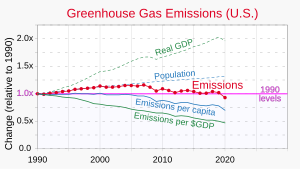
China
[edit]India
[edit]Greenhouse gas emissions by India are the third largest in the world and the main source is coal.[243] India emitted 2.8 Gt of CO2eq in 2016 (2.5 including LULUCF).[244][245] 79% were CO2, 14% methane and 5% nitrous oxide.[245] India emits about 3 gigatonnes (Gt) CO2eq of greenhouse gases each year; about two tons per person,[246] which is half the world average.[247] The country emits 7% of global emissions.[248]
In India in 2023, emissions increased by 190 million tonnes due to strong GDP growth and reduced hydroelectricity production following a weak monsoon, with its per capita emissions remaining significantly below the global average.[249]Society and culture
[edit]Impacts of the COVID-19 pandemic
[edit]In 2020, carbon dioxide emissions fell by 6.4% or 2.3 billion tonnes globally.[250] In April 2020, NOx emissions fell by up to 30%.[251] In China, lockdowns and other measures resulted in a 26% decrease in coal consumption, and a 50% reduction in nitrogen oxide emissions.[252] Greenhouse gas emissions rebounded later in the pandemic as many countries began lifting restrictions, with the direct impact of pandemic policies having a negligible long-term impact on climate change.[250][253]
See also
[edit]- Arctic methane emissions – Release of methane in the Arctic
- Carbon offsets and credits – Carbon dioxide reduction scheme
- List of locations and entities by greenhouse gas emissions
- Low-carbon economy – Climate-friendly economy
- Net zero emissions – Rate of human-caused greenhouse gas emissions
- World energy supply and consumption – Global production and usage of energy
References
[edit]- ^ ● Source for carbon emissions data: "Territorial (MtCO₂) / Emissions / Carbon emissions / Chart View". Global Carbon Atlas. 2024.
● Source for country population data: "Population 2022" (PDF). World Bank. 2024. Archived (PDF) from the original on 22 October 2024. (2022 data) - ^ "Chapter 2: Emissions trends and drivers" (PDF). Ipcc_Ar6_Wgiii. 2022. Archived from the original (PDF) on 2022-04-12. Retrieved 2022-04-04.
- ^ Ritchie, Hannah; Rosado, Pablo; Roser, Max (2023-12-28). "CO₂ and Greenhouse Gas Emissions". Our World in Data.
- ^ "Global Carbon Project (GCP)". www.globalcarbonproject.org. Archived from the original on 4 April 2019. Retrieved 2019-05-19.
- ^ a b c "Methane vs. Carbon Dioxide: A Greenhouse Gas Showdown". One Green Planet. 30 September 2014. Retrieved 13 February 2020.
- ^ Milman, Oliver (2024-04-06). "Scientists confirm record highs for three most important heat-trapping gases". The Guardian. ISSN 0261-3077. Retrieved 2024-04-08.
- ^ Ritchie, Hannah; Roser, Max; Rosado, Pablo (2020-05-11). "CO2 and Greenhouse Gas Emissions". Our World in Data.
- ^ a b widworld_admin (2021-10-20). "The World #InequalityReport 2022 presents the most up-to-date & complete data on inequality worldwide". World Inequality Report 2022 (in French). Retrieved 2023-07-14.
- ^ a b "Carbon inequality in 2030: Per capita consumption emissions and the 1.5C goal – IEEP AISBL". Retrieved 2023-07-14.
- ^ a b Gore, Tim (2021-11-05). Carbon Inequality in 2030: Per capita consumption emissions and the 1.5 °C goal. Institute for European Environmental Policy. doi:10.21201/2021.8274. hdl:10546/621305. ISBN 9781787488274. S2CID 242037589.
- ^ a b "AR6 Climate Change 2022: Mitigation of Climate Change — IPCC". Retrieved 2023-07-14.
- ^ a b c Grubb, M. (July–September 2003). "The economics of the Kyoto protocol" (PDF). World Economics. 4 (3). Archived from the original (PDF) on 17 July 2011.
- ^ "What is a carbon footprint". www.conservation.org. Retrieved 2023-05-28.
- ^ IPCC, 2022: Annex I: Glossary Archived 13 March 2023 at the Wayback Machine [van Diemen, R., J.B.R. Matthews, V. Möller, J.S. Fuglestvedt, V. Masson-Delmotte, C. Méndez, A. Reisinger, S. Semenov (eds)]. In IPCC, 2022: Climate Change 2022: Mitigation of Climate Change. Contribution of Working Group III to the Sixth Assessment Report of the Intergovernmental Panel on Climate Change Archived 2 August 2022 at the Wayback Machine [P.R. Shukla, J. Skea, R. Slade, A. Al Khourdajie, R. van Diemen, D. McCollum, M. Pathak, S. Some, P. Vyas, R. Fradera, M. Belkacemi, A. Hasija, G. Lisboa, S. Luz, J. Malley, (eds.)]. Cambridge University Press, Cambridge, UK and New York, NY, USA. doi: 10.1017/9781009157926.020
- ^ a b "Carbon Accounting". Corporate Finance Institute. Retrieved 2023-01-06.
- ^ "Solar Radiation and the Earth's Energy Balance". The Climate System – EESC 2100 Spring 2007. Columbia University. Archived from the original on 4 November 2004. Retrieved 15 October 2010.
- ^ Le Treut H, Somerville R, Cubasch U, Ding Y, Mauritzen C, Mokssit A, Peterson T, Prather M (2007). "Historical Overview of Climate Change Science" (PDF). In Solomon S, Qin D, Manning M, Chen Z, Marquis M, Averyt KB, Tignor M, Miller HL (eds.). Climate Change 2007: The Physical Science Basis. Contribution of Working Group I to the Fourth Assessment Report of the Intergovernmental Panel on Climate Change. Cambridge, UK and New York, NY: Cambridge University Press. p. 97. Archived from the original (PDF) on 26 November 2018. Retrieved 25 March 2014.
- ^ "The Elusive Absolute Surface Air Temperature (SAT)". Goddard Institute for Space Studies. NOAA. Archived from the original on 5 September 2015. Retrieved 3 September 2008.
- ^ "Yearly average temperature". Climate Change Tracker.
- ^ A concise description of the greenhouse effect is given in the Intergovernmental Panel on Climate Change Fourth Assessment Report, "What is the Greenhouse Effect?" FAQ 1.3 – AR4 WGI Chapter 1: Historical Overview of Climate Change Science Archived 5 August 2019 at the Wayback Machine, IIPCC Fourth Assessment Report, Chapter 1, page 115: "To balance the absorbed incoming [solar] energy, the Earth must, on average, radiate the same amount of energy back to space. Because the Earth is much colder than the Sun, it radiates at much longer wavelengths, primarily in the infrared part of the spectrum (see Figure 1). Much of this thermal radiation emitted by the land and ocean is absorbed by the atmosphere, including clouds, and reradiated back to Earth. This is called the greenhouse effect."
Schneider, Stephen H. (2001). "Global Climate Change in the Human Perspective". In Bengtsson, Lennart O.; Hammer, Claus U. (eds.). Geosphere-biosphere Interactions and Climate. Cambridge University Press. pp. 90–91. ISBN 978-0-521-78238-8. Archived from the original on 2 August 2020. Retrieved 31 May 2018.
Claussen, E.; Cochran, V.A.; Davis, D.P., eds. (2001). "Global Climate Data". Climate Change: Science, Strategies, & Solutions. University of Michigan. p. 373. ISBN 978-9004120242. Archived from the original on 18 May 2020. Retrieved 1 June 2018.
Allaby, A.; Allaby, M. (1999). A Dictionary of Earth Sciences. Oxford University Press. p. 244. ISBN 978-0-19-280079-4. - ^ Rebecca, Lindsey (14 January 2009). "Climate and Earth's Energy Budget : Feature Articles". earthobservatory.nasa.gov. Archived from the original on 21 January 2021. Retrieved 14 December 2020.
- ^ Fox, Alex. "Atmospheric Carbon Dioxide Reaches New High Despite Pandemic Emissions Reduction". Smithsonian Magazine. Archived from the original on 10 June 2021. Retrieved 22 June 2021.
- ^ Lindsey, Rebecca; Dahlman, Luann. "Climate Change: Global Temperature". NOAA Climate.gov.
- ^ a b Ritchie, Hannah; Roser, Max (11 May 2020). "Greenhouse gas emissions". Our World in Data. Retrieved 22 June 2021.
- ^ Dhakal, S., J.C. Minx, F.L. Toth, A. Abdel-Aziz, M.J. Figueroa Meza, K. Hubacek, I.G.C. Jonckheere, Yong-Gun Kim, G.F. Nemet, S. Pachauri, X.C. Tan, T. Wiedmann, 2022: Chapter 2: Emissions Trends and Drivers. In IPCC, 2022: Climate Change 2022: Mitigation of Climate Change. Contribution of Working Group III to the Sixth Assessment Report of the Intergovernmental Panel on Climate Change [P.R. Shukla, J. Skea, R. Slade, A. Al Khourdajie, R. van Diemen, D. McCollum, M. Pathak, S. Some, P. Vyas, R. Fradera, M. Belkacemi, A. Hasija, G. Lisboa, S. Luz, J. Malley, (eds.)]. Cambridge University Press, Cambridge, UK and New York, NY, USA. doi: 10.1017/9781009157926.004
- ^ "Water Vapor". earthobservatory.nasa.gov. 2023-06-30. Retrieved 2023-08-16.
- ^ Johnston, Chris; Milman, Oliver; Vidal, John (15 October 2016). "Climate change: global deal reached to limit use of hydrofluorocarbons". The Guardian. Retrieved 21 August 2018.
- ^ "Climate change: 'Monumental' deal to cut HFCs, fastest growing greenhouse gases". BBC News. 15 October 2016. Retrieved 15 October 2016.
- ^ "Nations, Fighting Powerful Refrigerant That Warms Planet, Reach Landmark Deal". The New York Times. 15 October 2016. Retrieved 15 October 2016.
- ^ Vaara, Miska (2003), Use of ozone depleting substances in laboratories, TemaNord, p. 170, ISBN 978-9289308847, archived from the original on 6 August 2011
- ^ Montreal Protocol
- ^ a b "NOAA's Annual Greenhouse Gas Index (An Introduction)". NOAA. 2020. Retrieved 2 November 2023.
- ^ Fox, Alex. "Atmospheric Carbon Dioxide Reaches New High Despite Pandemic Emissions Reduction". Smithsonian Magazine. Retrieved 22 June 2021.
- ^ "Executive Summary – CO2 Emissions in 2023 – Analysis". IEA. Retrieved 2024-03-30.
- ^ "It's critical to tackle coal emissions – Analysis". IEA. 8 October 2021. Retrieved 9 October 2021.
- ^ US EPA, OAR (12 January 2016). "Global Greenhouse Gas Emissions Data". www.epa.gov. Retrieved 13 September 2021.
- ^ Steinfeld, H.; Gerber, P.; Wassenaar, T.; Castel, V.; Rosales, M.; de Haan, C. (2006). Livestock's long shadow (Report). FAO Livestock, Environment and Development (LEAD) Initiative.
- ^ Ciais, Phillipe; Sabine, Christopher; et al. "Carbon and Other Biogeochemical Cycles" (PDF). In Stocker Thomas F.; et al. (eds.). Climate Change 2013: The Physical Science Basis. IPCC. p. 473.
- ^ Chrobak, Ula (14 May 2021). "Fighting climate change means taking laughing gas seriously". Knowable Magazine. doi:10.1146/knowable-051321-2. S2CID 236555111. Retrieved 8 March 2022.
- ^ "Global Methane Emissions and Mitigation Opportunities" (PDF). Global Methane Initiative. 2020.
- ^ "Sources of methane emissions". International Energy Agency. 20 August 2020.
- ^ "Key facts and findings". Fao.org. Food and Agricultural Organization. n.d. Archived from the original on 10 October 2023. Retrieved 25 October 2022.
- ^ PBL (21 December 2020). "Trends in Global CO2 and Total Greenhouse Gas Emissions; 2020 Report". PBL Netherlands Environmental Assessment Agency. Retrieved 8 September 2021.
- ^ IPCC (2019). "Summary for Policy Makers" (PDF). IPCC: 99. Archived from the original (PDF) on 2022-08-07. Retrieved 2022-04-04.
- ^ Dodman, David (April 2009). "Blaming cities for climate change? An analysis of urban greenhouse gas emissions inventories". Environment and Urbanization. 21 (1): 185–201. Bibcode:2009EnUrb..21..185D. doi:10.1177/0956247809103016. ISSN 0956-2478. S2CID 154669383.
- ^ "Just 100 companies responsible for 71% of global emissions, study says". The Guardian. 10 July 2017. Retrieved 9 April 2021.
- ^ Gustin, Georgina (9 July 2017). "25 Fossil Fuel Producers Responsible for Half Global Emissions in Past 3 Decades". Inside Climate News. Retrieved 4 May 2021.
- ^ a b c d Ritchie, Hannah; Roser, Max; Rosado, Pablo (2020-05-11). "CO2 and Greenhouse Gas Emissions". Our World in Data.
- ^ a b "Global CO2 emissions: annual increase halves in 2008". Netherlands Environmental Assessment Agency (PBL) website. 25 June 2009. Archived from the original on 19 December 2010. Retrieved 5 May 2010.
- ^ "Global Carbon Mechanisms: Emerging lessons and implications (CTC748)". Carbon Trust. March 2009. p. 24. Retrieved 31 March 2010.
- ^ Vaughan, Adam (7 December 2015). "Global emissions to fall for first time during a period of economic growth". The Guardian. ISSN 0261-3077. Retrieved 23 December 2016.
- ^ "CO2 emissions per capita vs GDP per capita". Our World in Data. Retrieved 2023-06-21.
- ^ a b c Friedlingstein, Pierre; O'Sullivan, Michael; Jones, Matthew W.; Anddrew, Robbie M.; et al. (11 November 2022). "Global Carbon Budget 2022 (Data description paper)". Earth System Science Data. 14 (11): 4811–4900. Bibcode:2022ESSD...14.4811F. doi:10.5194/essd-14-4811-2022. hdl:20.500.11850/594889. Data available for download at Our World in Data (cumulative and annual and per capita).
- ^ a b Bader, N.; Bleichwitz, R. (2009). "Measuring urban greenhouse gas emissions: The challenge of comparability". S.A.P.I.EN.S. 2 (3). Retrieved 11 September 2011.
- ^ "Transcript: The Path Forward: Al Gore on Climate and the Economy". Washington Post. ISSN 0190-8286. Retrieved 6 May 2021.
- ^ a b c d e f g Banuri, T. (1996). Equity and social considerations. In: Climate change 1995: Economic and social dimensions of climate change. Contribution of Working Group III to the Second Assessment Report of the Intergovernmental Panel on Climate Change (J.P. Bruce et al. Eds.). This version: Printed by Cambridge University Press, Cambridge, and New York. PDF version: IPCC website. ISBN 978-0521568548.
- ^ World energy outlook 2007 edition – China and India insights. International Energy Agency (IEA), Head of Communication and Information Office, 9 rue de la Fédération, 75739 Paris Cedex 15, France. 2007. p. 600. ISBN 978-9264027305. Archived from the original on 15 June 2010. Retrieved 4 May 2010.
- ^ Holtz-Eakin, D. (1995). "Stoking the fires? CO2 emissions and economic growth" (PDF). Journal of Public Economics. 57 (1): 85–101. doi:10.1016/0047-2727(94)01449-X. S2CID 152513329.
- ^ "Selected Development Indicators" (PDF). World Development Report 2010: Development and Climate Change (PDF). Washington, DC: The International Bank for Reconstruction and Development / The World Bank. 2010. Tables A1 and A2. doi:10.1596/978-0-8213-7987-5. ISBN 978-0821379875.
- ^ Helm, D.; et al. (10 December 2007). Too Good To Be True? The UK's Climate Change Record (PDF). p. 3. Archived from the original (PDF) on 15 July 2011.
- ^ a b c World Energy Outlook 2009 (PDF), Paris: International Energy Agency (IEA), 2009, pp. 179–80, ISBN 978-9264061309, archived from the original (PDF) on 24 September 2015, retrieved 27 December 2011
- ^ a b Davis, S.J.; K. Caldeira (8 March 2010). "Consumption-based Accounting of CO2 Emissions" (PDF). Proceedings of the National Academy of Sciences of the United States of America. 107 (12): 5687–5692. Bibcode:2010PNAS..107.5687D. doi:10.1073/pnas.0906974107. PMC 2851800. PMID 20212122. Retrieved 18 April 2011.
- ^ Herzog, T. (November 2006). Yamashita, M.B. (ed.). Target: intensity – an analysis of greenhouse gas intensity targets (PDF). World Resources Institute. ISBN 978-1569736388. Retrieved 11 April 2011.
- ^ Gore, Al (12 December 2020). "Opinion | Al Gore: Where I Find Hope". The New York Times. ISSN 0362-4331. Archived from the original on 18 August 2021. Retrieved 10 July 2021.
- ^ "Climate TRACE to track real-time global carbon emissions". Yale Climate Connections. 17 August 2020. Archived from the original on 12 July 2021. Retrieved 10 July 2021.
- ^ Freedman, Andrew. "Al Gore's Climate TRACE tracking group finds vast undercounts of emissions". Axios. Archived from the original on 27 September 2021. Retrieved 27 September 2021.
- ^ Roberts, David (16 July 2020). "The entire world's carbon emissions will finally be trackable in real time". Vox. Archived from the original on 10 July 2021. Retrieved 10 July 2021.
- ^ "Methane: A Threat to People and Planet". Rocky Mountain Institute. 7 July 2021. Archived from the original on 10 July 2021. Retrieved 10 July 2021.
- ^ "Transcript: The Path Forward: Al Gore on Climate and the Economy". The Washington Post. ISSN 0190-8286. Archived from the original on 25 April 2021. Retrieved 10 July 2021.
- ^ Puko, Timothy (13 April 2021). "John Kerry Says U.S. Will Hold China to Account on Climate Pledges". The Wall Street Journal. ISSN 0099-9660. Archived from the original on 10 July 2021. Retrieved 10 July 2021.
- ^ Peters, Adele (15 July 2020). "This Al Gore-supported project uses AI to track the world's emissions in near real time". Fast Company. Archived from the original on 12 May 2021. Retrieved 15 July 2021.
- ^ Botzen, W.J.W.; et al. (2008). "Cumulative CO2 emissions: shifting international responsibilities for climate debt". Climate Policy. 8 (6): 570. Bibcode:2008CliPo...8..569B. doi:10.3763/cpol.2008.0539. S2CID 153972794.
- ^ Buis, Alan (Oct 19, 2019). "The Atmosphere: Getting a Handle on Carbon Dioxide". Climate Change: Vital Signs of the Planet. Retrieved 2023-07-14.
- ^ "Methane and climate change – Global Methane Tracker 2022 – Analysis". IEA. Retrieved 2023-07-14.
- ^ Prather, Michael J.; Hsu, Juno; DeLuca, Nicole M.; Jackman, Charles H.; Oman, Luke D.; Douglass, Anne R.; Fleming, Eric L.; Strahan, Susan E.; Steenrod, Stephen D.; Søvde, O. Amund; Isaksen, Ivar S. A.; Froidevaux, Lucien; Funke, Bernd (2015-06-16). "Measuring and modeling the lifetime of nitrous oxide including its variability". Journal of Geophysical Research: Atmospheres. 120 (11): 5693–5705. Bibcode:2015JGRD..120.5693P. doi:10.1002/2015JD023267. ISSN 2169-897X. PMC 4744722. PMID 26900537.
- ^ "Climate Watch - Historical Emissions Data". World Resources Institute. Retrieved 23 October 2021.
- ^ a b c Höhne, N.; et al. (24 September 2010). "Contributions of individual countries' emissions to climate change and their uncertainty" (PDF). Climatic Change. 106 (3): 359–91. doi:10.1007/s10584-010-9930-6. S2CID 59149563. Archived from the original (PDF) on 26 April 2012.
- ^ Specktor, Brandon (1 October 2019). "Humans Are Disturbing Earth's Carbon Cycle More Than the Dinosaur-Killing Asteroid Did". livescience.com. Retrieved 8 July 2021.
- ^ "Transport emissions". ec.europa.eu. Retrieved 18 October 2021.
- ^ US EPA, OAR (10 September 2015). "Carbon Pollution from Transportation". www.epa.gov. Retrieved 18 October 2021.
- ^ "Rail and waterborne — best for low-carbon motorised transport — European Environment Agency". www.eea.europa.eu. Retrieved 18 October 2021.
- ^ "Luxembourg 2020 – Analysis". IEA. 25 March 2020. Retrieved 18 October 2021.
- ^ Ritchie, Hannah; Roser, Max (11 May 2020). "CO2 and Greenhouse Gas Emissions". Our World in Data.
- ^ "Why The Building Sector? – Architecture 2030". Retrieved 18 October 2021.
- ^ "Global Assessment: Urgent steps must be taken to reduce methane emissions this decade". United Nations. 6 May 2021.
- ^ a b Friedlingstein, Pierre; O'Sullivan, Michael; Jones, Matthew W.; Andrew, Robbie M.; Hauck, Judith; Olsen, Are; Peters, Glen P.; Peters, Wouter; Pongratz, Julia; Sitch, Stephen; Le Quéré, Corinne; Canadell, Josep G.; Ciais, Philippe; Jackson, Robert B.; Alin, Simone (2020). "Global Carbon Budget 2020" (PDF). Earth System Science Data. 12 (4): 3269–3340. Bibcode:2020ESSD...12.3269F. doi:10.5194/essd-12-3269-2020. ISSN 1866-3516.
- ^ "Global Carbon Budget 2019 | ICOS". www.icos-cp.eu.
- ^ Raupach, M.R.; et al. (2007). "Global and regional drivers of accelerating CO2 emissions" (PDF). Proc. Natl. Acad. Sci. USA. 104 (24): 10288–93. Bibcode:2007PNAS..10410288R. doi:10.1073/pnas.0700609104. PMC 1876160. PMID 17519334.
- ^ The cited paper uses the term "start date" instead of "base year".
- ^ Kühne, Kjell; Bartsch, Nils; Tate, Ryan Driskell; Higson, Julia; Habet, André (2022). ""Carbon Bombs" - Mapping key fossil fuel projects" (PDF). Energy Policy. 166: 112950. Bibcode:2022EnPol.16612950K. doi:10.1016/j.enpol.2022.112950. S2CID 248756651.
- ^ "Global Carbon Budget - Latest Data". Global Carbon Project. Retrieved 2023-06-18.
- ^ Olivier J.G.J. (2022), Trends in global CO2 and total greenhouse gas emissions: 2021 summary report Archived 2023-03-08 at the Wayback Machine. PBL Netherlands, Environmental Assessment Agency, The Hague.
- ^ IGSD (2013). "Short-Lived Climate Pollutants (SLCPs)". Institute of Governance and Sustainable Development (IGSD). Archived from the original on 2024-01-26. Retrieved 2024-08-09.
- ^ Zaelke, Durwood; Borgford-Parnell, Nathan; Andersen, Stephen; Picolotti, Romina; Clare, Dennis; Sun, Xiaopu; Gabrielle, Danielle (2013). "Primer on Short-Lived Climate Pollutants" (PDF). Institute for Governance and Sustainable Development. p. 3.
- ^ using 100 year global warming potential from IPCC-AR4
- ^ Dreyfus, Gabrielle B.; Xu, Yangyang; Shindell, Drew T.; Zaelke, Durwood; Ramanathan, Veerabhadran (31 May 2022). "Mitigating climate disruption in time: A self-consistent approach for avoiding both near-term and long-term global warming". Proceedings of the National Academy of Sciences. 119 (22): e2123536119. Bibcode:2022PNAS..11923536D. doi:10.1073/pnas.2123536119. ISSN 0027-8424. PMC 9295773. PMID 35605122. S2CID 249014617.
- ^ a b c d e f g h i j Olivier J.G.J. and Peters J.A.H.W. (2020), Trends in global CO2 and total greenhouse gas emissions: 2020 report Archived 2022-04-02 at the Wayback Machine. PBL Netherlands Archived 2021-09-09 at the Wayback Machine Environmental Assessment Agency, The Hague.
- ^ Lombrana, Laura Millan; Warren, Hayley; Rathi, Akshat (2020). "Measuring the Carbon-Dioxide Cost of Last Year's Worldwide Wildfires". Bloomberg L.P.
- ^ Global fire annual emissions (PDF) (Report). Global Fire Emissions Database.
- ^ World Meteorological Organization (January 2019). "Scientific Assessment of ozone Depletion: 2018" (PDF). Global Ozone Research and Monitoring Project. 58: A3 (see Table A1).
- ^ Thompson, R.L; Lassaletta, L.; Patra, P.K (2019). "Acceleration of global N2O emissions seen from two decades of atmospheric inversion" (PDF). Nature Climate Change. 9 (12). et al.: 993–998. Bibcode:2019NatCC...9..993T. doi:10.1038/s41558-019-0613-7. S2CID 208302708.
- ^ "Hydrogen 'twice as powerful a greenhouse gas as previously thought': UK government study". 8 April 2022. Retrieved 3 March 2023.
- ^ Ocko, Illisa; Hamburg, Steven (20 July 2022). "Climate consequences of hydrogen emissions" (PDF). Atmospheric Chemistry and Physics. 22 (14): 9349–9368. Bibcode:2022ACP....22.9349O. doi:10.5194/acp-22-9349-2022. S2CID 250930654. Retrieved 25 April 2023.
- ^ Cooper, Jasmin; Dubey, Luke; Bakkaloglu, Semra; Hawkes, Adam (2022-07-15). "Hydrogen emissions from the hydrogen value chain-emissions profile and impact to global warming". Science of the Total Environment. 830: 154624. Bibcode:2022ScTEn.83054624C. doi:10.1016/j.scitotenv.2022.154624. hdl:10044/1/96970. ISSN 0048-9697. PMID 35307429. S2CID 247535630.
- ^ Bond; et al. (2013). "Bounding the role of black carbon in the climate system: A scientific assessment". J. Geophys. Res. Atmos. 118 (11): 5380–5552. Bibcode:2013JGRD..118.5380B. doi:10.1002/jgrd.50171. hdl:2027.42/99106.
- ^ Ramanathan, V.; Carmichael, G. (April 2008). "Global and regional climate changes due to black carbon". Nature Geoscience. 1 (4): 221–227. Bibcode:2008NatGe...1..221R. doi:10.1038/ngeo156.
- ^ "Global Greenhouse Gas Emissions by Sector". EarthCharts. 6 March 2020. Retrieved 15 March 2020.
- ^ a b c "Life Cycle Assessment of Electricity Generation Options | UNECE". unece.org. Retrieved 2021-11-26.
- ^ IEA, CO2 Emissions from Fuel Combustion 2018: Highlights (Paris: International Energy Agency, 2018) p.98
- ^ IEA, CO2 Emissions from Fuel Combustion 2018: Highlights (Paris: International Energy Agency, 2018) p.101
- ^ Guevara, Marc; Enciso, Santiago; Tena, Carles; Jorba, Oriol; Dellaert, Stijn; Denier van der Gon, Hugo; Pérez García-Pando, Carlos (15 January 2024). "A global catalogue of CO2 emissions and co-emitted species from power plants, including high-resolution vertical and temporal profiles". Earth System Science Data. 16 (1): 337–373. Bibcode:2024ESSD...16..337G. doi:10.5194/essd-16-337-2024. hdl:2117/405068.
- ^ "Emissions". www.iea.org. Archived from the original on 12 August 2019. Retrieved 21 September 2019.
- ^ "We have too many fossil-fuel power plants to meet climate goals". Environment. 1 July 2019. Archived from the original on July 2, 2019. Retrieved 21 September 2019.
- ^ "March: Tracking the decoupling of electricity demand and associated CO2 emissions". www.iea.org. Retrieved 21 September 2019.
- ^ Grant, Don; Zelinka, David; Mitova, Stefania (13 July 2021). "Reducing CO2 emissions by targeting the world's hyper-polluting power plants". Environmental Research Letters. 16 (9): 094022. Bibcode:2021ERL....16i4022G. doi:10.1088/1748-9326/ac13f1. ISSN 1748-9326.
- ^ Emission Trends and Drivers, Chap. 2 in "Climate Change 2022: Mitigation of Climate Change" https://www.ipcc.ch/report/ar6/wg3/ Archived 2022-08-02 at the Wayback Machine
- ^ a b "CO2 Emissions in 2023 – Analysis". IEA. March 2024. Retrieved 2024-03-22.
- ^ Nabuurs, G-J.; Mrabet, R.; Abu Hatab, A.; Bustamante, M.; et al. "Chapter 7: Agriculture, Forestry and Other Land Uses (AFOLU)" (PDF). Climate Change 2022: Mitigation of Climate Change. p. 750. doi:10.1017/9781009157926.009..
- ^ Steinfeld H, Gerber P, Wassenaar T, Castel V, Rosales M, de Haan C (2006). Livestock's long shadow: environmental issues and options (PDF). Food and Agriculture Organization of the UN. ISBN 978-92-5-105571-7. Archived from the original (PDF) on 25 June 2008.
- ^ FAO (2020). Emissions due to agriculture. Global, regional and country trends 2000–2018 (PDF) (Report). FAOSTAT Analytical Brief Series. Vol. 18. Rome. p. 2. ISSN 2709-0078.
- ^ Section 4.2: Agriculture's current contribution to greenhouse gas emissions, in: HLPE (June 2012). Food security and climate change. A report by the High Level Panel of Experts (HLPE) on Food Security and Nutrition of the Committee on World Food Security. Rome, Italy: Food and Agriculture Organization of the United Nations. pp. 67–69. Archived from the original on 12 December 2014.
- ^ Sarkodie, Samuel A.; Ntiamoah, Evans B.; Li, Dongmei (2019). "Panel heterogeneous distribution analysis of trade and modernized agriculture on CO2 emissions: The role of renewable and fossil fuel energy consumption". Natural Resources Forum. 43 (3): 135–153. doi:10.1111/1477-8947.12183. ISSN 1477-8947.
- ^ "Carbon emissions from fertilizers could be reduced by as much as 80% by 2050". Science Daily. University of Cambridge. Retrieved 17 February 2023.
- ^ "How livestock farming affects the environment". www.downtoearth.org.in. Retrieved 2022-02-10.
- ^ Friel, Sharon; Dangour, Alan D.; Garnett, Tara; et al. (2009). "Public health benefits of strategies to reduce greenhouse-gas emissions: food and agriculture". The Lancet. 374 (9706): 2016–2025. doi:10.1016/S0140-6736(09)61753-0. PMID 19942280. S2CID 6318195.
- ^ "The carbon footprint of foods: are differences explained by the impacts of methane?". Our World in Data. Retrieved 2023-04-14.
- ^ United Nations Environment Programme (2022). Emissions Gap Report 2022: The Closing Window — Climate crisis calls for rapid transformation of societies. Nairobi.
- ^ "Bovine Genomics | Genome Canada". www.genomecanada.ca. Archived from the original on 10 August 2019. Retrieved 2 August 2019.
- ^ Airhart, Ellen. "Canada Is Using Genetics to Make Cows Less Gassy". Wired – via www.wired.com.
- ^ "The use of direct-fed microbials for mitigation of ruminant methane emissions: a review".
- ^ Parmar, N.R.; Nirmal Kumar, J.I.; Joshi, C.G. (2015). "Exploring diet-dependent shifts in methanogen and methanotroph diversity in the rumen of Mehsani buffalo by a metagenomics approach". Frontiers in Life Science. 8 (4): 371–378. doi:10.1080/21553769.2015.1063550. S2CID 89217740.
- ^ "Kowbucha, seaweed, vaccines: the race to reduce cows' methane emissions". The Guardian. 30 September 2021. Retrieved 1 December 2021.
- ^ Boadi, D (2004). "Mitigation strategies to reduce enteric methane emissions from dairy cows: Update review". Can. J. Anim. Sci. 84 (3): 319–335. doi:10.4141/a03-109.
- ^ Martin, C. et al. 2010. Methane mitigation in ruminants: from microbe to the farm scale. Animal 4 : pp 351-365.
- ^ Eckard, R. J.; et al. (2010). "Options for the abatement of methane and nitrous oxide from ruminant production: A review". Livestock Science. 130 (1–3): 47–56. doi:10.1016/j.livsci.2010.02.010.
- ^ a b Feng, Yu; Zeng, Zhenzhong; Searchinger, Timothy D.; Ziegler, Alan D.; Wu, Jie; Wang, Dashan; He, Xinyue; Elsen, Paul R.; Ciais, Philippe; Xu, Rongrong; Guo, Zhilin; Peng, Liqing; Tao, Yiheng; Spracklen, Dominick V.; Holden, Joseph; Liu, Xiaoping; Zheng, Yi; Xu, Peng; Chen, Ji; Jiang, Xin; Song, Xiao-Peng; Lakshmi, Venkataraman; Wood, Eric F.; Zheng, Chunmiao (28 February 2022). "Doubling of annual forest carbon loss over the tropics during the early twenty-first century" (PDF). Nature Sustainability. 5 (5): 444–451. Bibcode:2022NatSu...5..444F. doi:10.1038/s41893-022-00854-3. ISSN 2398-9629. S2CID 247160560.
- ^ "Deforestation emissions far higher than previously thought, study finds". The Guardian. 28 February 2022. Retrieved 16 March 2022.
- ^ Fig. SPM.2c from Working Group III (4 April 2022). Climate Change 2022 / Mitigation of Climate Change / Summary for Policymakers (PDF). Intergovernmental Panel on Climate Change. p. 10. ISBN 978-92-9169-160-9. Archived (PDF) from the original on 22 July 2023. GDP data is for 2019.
- ^ B. Metz; O.R. Davidson; P.R. Bosch; R. Dave; L.A. Meyer (eds.), Annex I: Glossary J–P, archived from the original on 3 May 2010
- ^ Markandya, A. (2001). "7.3.5 Cost Implications of Alternative GHG Emission Reduction Options and Carbon Sinks". In B. Metz; et al. (eds.). Costing Methodologies. Climate Change 2001: Mitigation. Contribution of Working Group III to the Third Assessment Report of the Intergovernmental Panel on Climate Change. Print version: Cambridge University Press, Cambridge, and New York. This version: GRID-Arendal website. ISBN 978-0521015028. Archived from the original on 5 August 2011. Retrieved 11 April 2011.
- ^ Page, S.; Siegert, F.; Rieley, J.; Boehm, H.; Jaya, A.; Limin, S. (2002). "The amount of carbon released from peat and forest fires in Indonesia during 1997". Nature. 420 (6911): 61–65. Bibcode:2002Natur.420...61P. doi:10.1038/nature01131. PMID 12422213. S2CID 4379529.
- ^ Lazaroff, Cat (2002-11-08). "Indonesian Wildfires Accelerated Global Warming". Environment New Service. Archived from the original on 8 September 2019. Retrieved 2011-11-07.
- ^ Pearce, Fred (6 November 2004). "Massive peat burn is speeding climate change". New Scientist.
- ^ Ge, Mengpin; Friedrich, Johannes; Vigna, Leandro (6 February 2020). "4 Charts Explain Greenhouse Gas Emissions by Countries and Sectors". World Resources Institute. Retrieved 30 December 2020.
- ^ "Cars, planes, trains: where do CO2 emissions from transport come from?". Our World in Data. Retrieved 19 June 2021.
- ^ "EU countries agree to 30 percent cut in truck CO2 emissions". Reuters. 20 December 2018.
- ^ Walker TR, Adebambo O, Del Aguila Feijoo MC, Elhaimer E, Hossain T, Edwards SJ, Morrison CE, Romo J, Sharma N, Taylor S, Zomorodi S (2019). "Environmental Effects of Marine Transportation". World Seas: An Environmental Evaluation. pp. 505–530. doi:10.1016/B978-0-12-805052-1.00030-9. ISBN 978-0-12-805052-1. S2CID 135422637.
- ^ Vidal, John (2009-04-09). "Health risks of shipping pollution have been 'underestimated'". The Guardian. Retrieved 2009-07-03.
- ^ "Infrastructure Podcast; Decarbonized Shipping". World Bank. 2022-03-16. Retrieved 2022-08-18.
- ^ Kersing, Arjen; Stone, Matt (2022-01-25). "Charting global shipping's path to zero carbon". McKinsey. Retrieved 2022-08-18.
- ^ Raucci, Carlo (2019-06-06). "Three pathways to shipping's decarbonization". Global Maritime Forum. Retrieved 2022-08-18.
- ^ Brandon Graver; Kevin Zhang; Dan Rutherford (September 2019). "CO2 emissions from commercial aviation, 2018" (PDF). International Council on Clean Transportation.
- ^ Davidson, Jordan (4 September 2020). "Aviation Accounts for 3.5% of Global Warming Caused by Humans, New Research Says". Ecowatch. Retrieved 6 September 2020.
- ^ "Average passenger aircraft emissions and energy consumption per passenger kilometre in Finland 2008". lipasto.vtt.fi. Archived from the original on 19 July 2011. Retrieved 3 July 2009.
- ^ a b Ürge-Vorsatz, Diana; Khosla, Radhika; Bernhardt, Rob; Chan, Yi Chieh; Vérez, David; Hu, Shan; Cabeza, Luisa F. (2020). "Advances Toward a Net-Zero Global Building Sector". Annual Review of Environment and Resources. 45: 227–269. doi:10.1146/annurev-environ-012420-045843. hdl:10459.1/69710.
- ^ "Why the building sector?". Architecture 2020. Retrieved 1 April 2021.
- ^ Fowlie, Meredith; Greenstone, Michael; Wolfram, Catherine (2018-08-01). "Do Energy Efficiency Investments Deliver? Evidence from the Weatherization Assistance Program". The Quarterly Journal of Economics. 133 (3): 1597–1644. doi:10.1093/qje/qjy005. ISSN 0033-5533. Archived from the original on 2020-06-07. Retrieved 2020-11-21.
- ^ "Sequestering Carbon in Buildings". Green Energy Times. 23 June 2017. Retrieved 22 January 2021.
- ^ "IPCC — Intergovernmental Panel on Climate Change". Retrieved 4 April 2022.
- ^ a b c d International Energy Agency (2019). Global Status Report for Buildings and Construction 2019. Paris: IEA. ISBN 978-92-807-3768-4. Archived from the original on 2020-11-26. Retrieved 2020-11-20.
- ^ "CoatingsTech - Coatings and Low-carbon Cement Technology". www.coatingstech-digital.org. Retrieved 2022-07-07.
- ^ De Ras, Kevin; Van De Vijver, Ruben; Galvita, Vladimir V.; Marin, Guy B.; Van Geem, Kevin M. (2019-12-01). "Carbon capture and utilization in the steel industry: challenges and opportunities for chemical engineering". Current Opinion in Chemical Engineering. 26: 81–87. Bibcode:2019COCE...26...81D. doi:10.1016/j.coche.2019.09.001. hdl:1854/LU-8635595. ISSN 2211-3398. S2CID 210619173. Archived from the original on 2021-05-20. Retrieved 2021-07-02.
- ^ Alter, Lloyd (1 April 2019). "Let's rename "Embodied Carbon" to "Upfront Carbon Emissions"". TreeHugger. Archived from the original on 1 April 2019. Retrieved 10 August 2019.
- ^ "New Buildings: Embodied Carbon". Architecture 2030. Archived from the original on 12 December 2018. Retrieved 10 August 2019.
- ^ Pomponi, Francesco; Moncaster, Alice (2016). "Embodied carbon mitigation and reduction in the built environment - What does the evidence say?". Journal of Environmental Management. 181: 687–700. Bibcode:2016JEnvM.181..687P. doi:10.1016/j.jenvman.2016.08.036. PMID 27558830. Archived from the original on 2021-11-20. Retrieved 2021-07-27.
- ^ "The World's Biggest Emitter of Greenhouse Gases". Bloomberg.com. 17 March 2020. Retrieved 29 December 2020.
- ^ Global, Regional, and National CO2 Emissions Archived 2007-07-11 at the Wayback Machine. In Trends: A Compendium of Data on Global Change, Marland, G., T.A. Boden, and R. J. Andres, 2005, Carbon Dioxide Information Analysis Center, Oak Ridge National Laboratory, U.S. Department of Energy, Oak Ridge, Tennessee.
- ^ "Global Gas Flaring Reduction Partnership (GGFR)". worldbank.org. The World Bank. Archived from the original on August 26, 2016. Retrieved August 24, 2016.
previous redirect from web.worldbank.org
- ^ Tsaia, I-Tsung; Al Alia, Meshayel; El Waddi, Sanaâ; Adnan Zarzourb, aOthman (2013). "Carbon Capture Regulation for the Steel and Aluminum Industries in the UAE: An Empirical Analysis". Energy Procedia. 37: 7732–7740. Bibcode:2013EnPro..37.7732T. doi:10.1016/j.egypro.2013.06.719. ISSN 1876-6102. OCLC 5570078737.
- ^ Zheng, Jiajia; Suh, Sangwon (May 2019). "Strategies to reduce the global carbon footprint of plastics" (PDF). Nature Climate Change. 9 (5): 374–378. Bibcode:2019NatCC...9..374Z. doi:10.1038/s41558-019-0459-z. ISSN 1758-6798. S2CID 145873387.
- ^ "The Link Between Plastic Use and Climate Change: Nitty-gritty". stanfordmag.org. 2009. Retrieved 5 March 2021.
... According to the EPA, approximately one ounce of carbon dioxide is emitted for each ounce of polyethylene (PET) produced. PET is the type of plastic most commonly used for beverage bottles. ...'
- ^ Glazner, Elizabeth (21 November 2017). "Plastic Pollution and Climate Change". Plastic Pollution Coalition. Retrieved 6 August 2018.
- ^ Blue, Marie-Luise (11 June 2018). "What Is the Carbon Footprint of a Plastic Bottle?". Sciencing. Leaf Group Ltd. Retrieved 6 August 2018.
- ^ Royer, Sarah-Jeanne; Ferrón, Sara; Wilson, Samuel T.; Karl, David M. (1 August 2018). "Production of methane and ethylene from plastics in the environment". PLOS ONE. 13 (Plastic, Climate Change): e0200574. Bibcode:2018PLoSO..1300574R. doi:10.1371/journal.pone.0200574. PMC 6070199. PMID 30067755.
- ^ Rosane, Olivia (2 August 2018). "Study Finds New Reason to Ban Plastic: It Emits Methane in the Sun". No. Plastic, Climate Change. Ecowatch. Retrieved 6 August 2018.
- ^ "Sweeping New Report on Global Environmental Impact of Plastics Reveals Severe Damage to Climate". Center for International Environmental Law (CIEL). Retrieved 16 May 2019.
- ^ Plastic & Climate The Hidden Costs of a Plastic Planet (PDF). Center for International Environmental Law, Environmental Integrity Project, FracTracker Alliance, Global Alliance for Incinerator Alternatives, 5 Gyres, and Break Free From Plastic. May 2019. pp. 82–85. Retrieved 20 May 2019.
- ^ "World GHG Emissions Flow Chart" (PDF). Ecofys.com. 2010. Archived from the original (PDF) on 6 November 2018. Retrieved 16 August 2018.
- ^ "Data Centres and Data Transmission Networks – Analysis". IEA. Retrieved 2022-03-06.
- ^ Freitag, Charlotte; Berners-Lee, Mike (December 2020). "The climate impact of ICT: A review of estimates, trends and regulations". arXiv:2102.02622 [physics.soc-ph].
- ^ "The computer chip industry has a dirty climate secret". the Guardian. 18 September 2021. Retrieved 18 September 2021.
- ^ "Working from home is erasing carbon emissions -- but for how long?". Grist. 19 May 2020. Retrieved 4 April 2021.
- ^ Cunliff, Colin (6 July 2020). "Beyond the Energy Techlash: The Real Climate Impacts of Information Technology".
- ^ Foteinis, Spyros (7 February 2018). "Bitcoin's alarming carbon footprint". Nature. 554 (7691): 169. Bibcode:2018Natur.554..169F. doi:10.1038/d41586-018-01625-x.
- ^ Krause, Max J.; Tolaymat, Thabet (November 2018). "Quantification of energy and carbon costs for mining cryptocurrencies". Nature Sustainability. 1 (11): 711–718. Bibcode:2018NatSu...1..711K. doi:10.1038/s41893-018-0152-7. S2CID 169170289.
- ^ Davies, Pascale (26 February 2022). "Bitcoin mining is worse for the environment now since China banned it". euronews. Retrieved 1 March 2022.
- ^ Ponciano, Jonathan. "Bill Gates Sounds Alarm On Bitcoin's Energy Consumption–Here's Why Crypto Is Bad For Climate Change". Forbes. Retrieved 30 July 2021.
- ^ Huang, Jon; O'Neill, Claire; Tabuchi, Hiroko (3 September 2021). "Bitcoin Uses More Electricity Than Many Countries. How Is That Possible?". The New York Times. ISSN 0362-4331. Retrieved 1 March 2022.
- ^ "Bitcoin energy consumption worldwide 2017-2021". Statista. Retrieved 1 March 2022.
- ^ Andrae, Anders; Edler, Tomas (2015). "On Global Electricity Usage of Communication Technology: Trends to 2030". Challenges. 6 (1): 117–157. doi:10.3390/challe6010117. ISSN 2078-1547.
 Text was copied from this source, which is available under a Creative Commons Attribution 4.0 International License
Text was copied from this source, which is available under a Creative Commons Attribution 4.0 International License
- ^ J. Eckelman, Matthew; Huang, Kaixin; Dubrow, Robert; D. Sherman, Jodi (December 2020). "Health Care Pollution And Public Health Damage In The United States: An Update". Health Affairs. 39 (12): 2071–2079. doi:10.1377/hlthaff.2020.01247. PMID 33284703.
- ^ Eckelman, Matthew J.; Sherman, Jodi D. (April 2018). "Estimated Global Disease Burden From US Health Care Sector Greenhouse Gas Emissions". American Journal of Public Health. 108 (S2): S120 – S122. doi:10.2105/AJPH.2017.303846. ISSN 0090-0036. PMC 5922190. PMID 29072942.
- ^ Howard, Guy; Calow, Roger; Macdonald, Alan; Bartram, Jamie (2016). "Climate Change and Water and Sanitation: Likely Impacts and Emerging Trends for Action". Annual Review of Environment and Resources. 41 (1): 253–276. doi:10.1146/annurev-environ-110615-085856. ISSN 1543-5938. S2CID 155259589.
- ^ a b c d Alix, Alexandre; Bellet, Laurent; Trommsdorff, Corinne; Audureau, Iris, eds. (2022). Reducing the Greenhouse Gas Emissions of Water and Sanitation Services: Overview of emissions and their potential reduction illustrated by utility know-how. IWA Publishing. doi:10.2166/9781789063172. ISBN 978-1-78906-317-2. S2CID 250128707.
- ^ "Environmental Impacts of Tourism – Global Level". UNEP.
- ^ "IPCC Working Group III – Mitigation of Climate Change, Annex III: Technology – specific cost and performance parameters – Table A.III.2 (Emissions of selected electricity supply technologies (gCO2-eq/kWh))" (PDF). IPCC. 2014. p. 1335. Archived (PDF) from the original on 14 December 2018. Retrieved 14 December 2018.
- ^ "Full lifecycle emissions intensity of global coal and gas supply for heat generation, 2018 – Charts – Data & Statistics". IEA. Archived from the original on 24 June 2020. Retrieved 2020-07-30.
- ^ Nuclear Power Results – Life Cycle Assessment Harmonization Archived 2 July 2013 at the Wayback Machine, NREL Laboratory, Alliance For Sustainable Energy LLC website, U.S. Department Of Energy, last updated: 24 January 2013.
- ^ Climate Equality: a Climate for the 99% (PDF). Oxfam International. November 2023. Archived (PDF) from the original on 23 November 2023. Fig. ES.2, Fig. ES.3, Box 1.2.
- ^ a b Cozzi, Laura; Chen, Olivia; Kim, Hyeji (22 February 2023). "The world's top 1% of emitters produce over 1000 times more CO2 than the bottom 1%". iea.org. International Energy Agency (IEA). Archived from the original on 3 March 2023. "Methodological note: ... The analysis accounts for energy-related CO2, and not other greenhouse gases, nor those related to land use and agriculture."
- ^ Stevens, Harry (1 March 2023). "The United States has caused the most global warming. When will China pass it?". The Washington Post. Archived from the original on 1 March 2023.
- ^ Rapid Transition Alliance, 13 April 2021 "Cambridge Sustainability Commission Report on Scaling Behaviour Change" Archived 2022-02-05 at the Wayback Machine p. 20
- ^ Emission trends and drivers, Ch 2 in "Climate Change 2022: Mitigation of Climate Change". http://www.ipcc.ch. Retrieved 5 April 2022.
- ^ a b Climate Change 2022 ipcc.chArchived 4 April 2022 at the Wayback Machine
- ^ Wiedmann, Thomas; Lenzen, Manfred; Keyßer, Lorenz T.; Steinberger, Julia K. (19 June 2020). "Scientists' warning on affluence". Nature Communications. 11 (1): 3107. Bibcode:2020NatCo..11.3107W. doi:10.1038/s41467-020-16941-y. ISSN 2041-1723. PMC 7305220. PMID 32561753.
- ^ Nielsen, Kristian S.; Nicholas, Kimberly A.; Creutzig, Felix; Dietz, Thomas; Stern, Paul C. (30 September 2021). "The role of high-socioeconomic-status people in locking in or rapidly reducing energy-driven greenhouse gas emissions". Nature Energy. 6 (11): 1011–1016. Bibcode:2021NatEn...6.1011N. doi:10.1038/s41560-021-00900-y. ISSN 2058-7546. S2CID 244191460.
- ^ Gore, Tim (2020-09-23). "Confronting carbon inequality". Oxfam International. Archived from the original on 24 March 2022. Retrieved 2022-03-20.
- ^ Kartha, Sivan; Kemp-Benedict, Eric; Ghosh, Emily; Nazareth, Anisha; Gore, Tim (September 2020). "The Carbon Inequality Era: An assessment of the global distribution of consumption emissions among individuals from 1990 to 2015 and beyond" (PDF). Stockholm Environment Institute. Archived (PDF) from the original on 22 January 2022. Retrieved 11 May 2022.
- ^ Clifford, Catherine (26 January 2021). "The '1%' are the main drivers of climate change, but it hits the poor the hardest: Oxfam report". CNBC. Archived from the original on 28 October 2021. Retrieved 28 October 2021.
- ^ Berkhout, Esmé; Galasso, Nick; Lawson, Max; Rivero Morales, Pablo Andrés; Taneja, Anjela; Vázquez Pimentel, Diego Alejo (25 January 2021). "The Inequality Virus". Oxfam International. Archived from the original on 28 October 2021. Retrieved 28 October 2021.
- ^ "Emissions Gap Report 2020 / Executive Summary" (PDF). United Nations Environment Programme. 2021. p. XV Fig. ES.8. Archived (PDF) from the original on 31 July 2021.
- ^ Paddison, Laura (28 October 2021). "How the rich are driving climate change". BBC. Archived from the original on 5 November 2021. Retrieved 7 November 2021.
- ^ Oswald, Yannick; Owen, Anne; Steinberger, Julia K. (March 2020). "Large inequality in international and intranational energy footprints between income groups and across consumption categories" (PDF). Nature Energy. 5 (3): 231–239. Bibcode:2020NatEn...5..231O. doi:10.1038/s41560-020-0579-8. ISSN 2058-7546. S2CID 216245301. Archived (PDF) from the original on 28 October 2021. Retrieved 16 November 2021.
- ^ Timperley, Jocelyn. "Who is really to blame for climate change?". www.bbc.com. Retrieved 8 June 2022.
- ^ Zheng, Heran; Long, Yin; Wood, Richard; Moran, Daniel; Zhang, Zengkai; Meng, Jing; Feng, Kuishuang; Hertwich, Edgar; Guan, Dabo (March 2022). "Ageing society in developed countries challenges carbon mitigation". Nature Climate Change. 12 (3): 241–248. Bibcode:2022NatCC..12..241Z. doi:10.1038/s41558-022-01302-y. hdl:11250/3027882. ISSN 1758-6798. S2CID 247322718.
- ^ Compilation and synthesis of fifth national communications. Executive summary. Note by the secretariat (PDF). Geneva (Switzerland): United Nations Framework Convention on Climate Change (UNFCCC). 2011. pp. 9–10.
- ^ Fawzy, Samer; Osman, Ahmed I.; Doran, John; Rooney, David W. (2020). "Strategies for mitigation of climate change: a review". Environmental Chemistry Letters. 18 (6): 2069–2094. Bibcode:2020EnvCL..18.2069F. doi:10.1007/s10311-020-01059-w.
- ^ Abbass, Kashif; Qasim, Muhammad Zeeshan; Song, Huaming; Murshed, Muntasir; Mahmood, Haider; Younis, Ijaz (2022). "A review of the global climate change impacts, adaptation, and sustainable mitigation measures". Environmental Science and Pollution Research. 29: 42539–42559. doi:10.1007/s11356-022-19718-6. PMC 8978769.
- ^ Ritchie, Hannah; Roser, Max; Rosado, Pablo (11 May 2020). "CO2 and Greenhouse Gas Emissions". Our World in Data. Retrieved 27 August 2022.
- ^ Rogelj, J.; Shindell, D.; Jiang, K.; Fifta, S.; et al. (2018). "Chapter 2: Mitigation Pathways Compatible with 1.5 °C in the Context of Sustainable Development" (PDF). Global Warming of 1.5 °C. An IPCC Special Report on the impacts of global warming of 1.5 °C above pre-industrial levels and related global greenhouse gas emission pathways, in the context of strengthening the global response to the threat of climate change, sustainable development, and efforts to eradicate poverty (PDF).
- ^ Harvey, Fiona (26 November 2019). "UN calls for push to cut greenhouse gas levels to avoid climate chaos". The Guardian. Retrieved 27 November 2019.
- ^ "Cut Global Emissions by 7.6 Percent Every Year for Next Decade to Meet 1.5°C Paris Target – UN Report". United Nations Framework Convention on Climate Change. United Nations. Retrieved 27 November 2019.
- ^ IPCC (2022) Summary for policy makers in Climate Change 2022: Mitigation of Climate Change. Contribution of Working Group III to the Sixth Assessment Report of the Intergovernmental Panel on Climate Change, Cambridge University Press, Cambridge, United Kingdom and New York, NY, United States
- ^ Ram M., Bogdanov D., Aghahosseini A., Gulagi A., Oyewo A.S., Child M., Caldera U., Sadovskaia K., Farfan J., Barbosa LSNS., Fasihi M., Khalili S., Dalheimer B., Gruber G., Traber T., De Caluwe F., Fell H.-J., Breyer C. Global Energy System based on 100% Renewable Energy – Power, Heat, Transport and Desalination Sectors Archived 2021-04-01 at the Wayback Machine. Study by Lappeenranta University of Technology and Energy Watch Group, Lappeenranta, Berlin, March 2019.
- ^ "Cement – Analysis". IEA. Retrieved 24 November 2022.
- ^ a b EIA (October 2023). International Energy Outlook 2023 (PDF). Washington DC, USA: US Energy Information Administration (EIA). Retrieved 2023-10-11. Informally describes as a "narrative" and tagged IEO2023.
- ^ EIA (11 October 2023). "International Energy Outlook 2023 — Landing page". US Energy Information Administration (EIA). Washington DC, USA. Retrieved 2023-10-13. Landing page.
- ^ CSIS (11 October 2023). US EIA's International Energy Outlook 2023. Washington DC, USA: Center for Strategic and International Studies (SCIS). Retrieved 2023-10-13. YouTube. Duration: 00:57:12. Includes interview with Joseph DeCarolis.
- ^ a b United Nations Environment Programme (2022). Emissions Gap Report 2022: The Closing Window — Climate crisis calls for rapid transformation of societies. Nairobi.
- ^ "It's over for fossil fuels: IPCC spells out what's needed to avert climate disaster". The Guardian. 4 April 2022. Retrieved 4 April 2022.
- ^ "The evidence is clear: the time for action is now. We can halve emissions by 2030". IPCC. 4 April 2022. Retrieved 4 April 2022.
- ^ "Ambitious Action Key to Resolving Triple Planetary Crisis of Climate Disruption, Nature Loss, Pollution, Secretary-General Says in Message for International Mother Earth Day | Meetings Coverage and Press Releases". www.un.org. Retrieved 10 June 2022.
- ^ a b "Fossil CO2 emissions of all world countries - 2020 report". EDGAR - Emissions Database for Global Atmospheric Research.
 This article incorporates text available under the CC BY 4.0 license.
This article incorporates text available under the CC BY 4.0 license.
- ^ "Climate Change Indicators: U.S. Greenhouse Gas Emissions / Figure 3. U.S. Greenhouse Gas Emissions per Capita and per Dollar of GDP, 1990–2020". EPA.gov. U.S. Environmental Protection Agency. 27 June 2016. Archived from the original on 5 April 2023.
- ^ US EPA, OAR (2017-02-08). "Inventory of U.S. Greenhouse Gas Emissions and Sinks". www.epa.gov. Retrieved 2022-08-04.
- ^ "Report: China emissions exceed all developed nations combined". BBC News. 2021-05-07.
- ^ "Cumulative CO2 emissions globally by country 2018". Statista. Retrieved 2021-02-19.
- ^ "The world is still falling short of meeting its climate goals". Environment. 2021-10-26. Archived from the original on October 26, 2021. Retrieved 2021-10-28.
- ^ "Who has contributed most to global CO2 emissions?". Our World in Data. Retrieved 2021-12-29.
- ^ Ge, Mengpin; Friedrich, Johannes; Vigna, Leandro (2020-02-06). "4 Charts Explain Greenhouse Gas Emissions by Countries and Sectors". World Resources Institute. Retrieved 2020-04-29.
- ^ ● Source for carbon emissions data: "Territorial (MtCO₂) / Emissions / Carbon emissions / Chart View". Global Carbon Atlas. 2024.
● Source for country population data: "Population 2022" (PDF). World Bank. 2024. Archived (PDF) from the original on 22 October 2024. - ^ Chart based on: Milman, Oliver (12 July 2022). "Nearly $2tn of damage inflicted on other countries by US emissions". The Guardian. Archived from the original on 12 July 2022. Guardian cites Callahan, Christopher W.; Mankin, Justin S. (12 July 2022). "National attribution of historical climate damages". Climatic Change. 172 (40): 40. Bibcode:2022ClCh..172...40C. doi:10.1007/s10584-022-03387-y. S2CID 250430339.
- ^ "The Carbon Brief Profile: India". Carbon Brief. 2019-03-14. Retrieved 2019-09-25.
- ^ Government of India (2018) India Second Biennial Update Report to the United Nations Framework Convention on Climate Change
- ^ a b "India: Third Biennial Update Report to The United Nations Framework Convention on Climate Change" (PDF). Archived (PDF) from the original on 2021-02-27.
- ^ "By 2030, Cut Per Capita Emission to Global Average: India to G20". The Leading Solar Magazine In India. 26 July 2021. Retrieved 2021-09-17.
- ^ "Greenhouse Gas Emissions in India" (PDF). September 2018. Archived (PDF) from the original on 2020-02-14. Retrieved 10 June 2021.
- ^ "Emissions Gap Report 2019". UN Environment Programme. 2019. Archived from the original on 2019-11-20. Retrieved 10 June 2021.
- ^ "CO2 Emissions in 2023 – Analysis". IEA. March 2024. Retrieved 2024-03-22.
- ^ a b Tollefson J (January 2021). "COVID curbed carbon emissions in 2020 - but not by much". Nature. 589 (7842): 343. Bibcode:2021Natur.589..343T. doi:10.1038/d41586-021-00090-3. PMID 33452515. S2CID 231622354.
- ^ Forster PM, Forster HI, Evans MJ, Gidden MJ, Jones CD, Keller CA, et al. (August 2020). "Erratum: Publisher Correction: Current and future global climate impacts resulting from COVID-19". Nature Climate Change. 10 (10): 971. doi:10.1038/s41558-020-0904-z. PMC 7427494. PMID 32845944.
- ^ Rume T, Islam SM (September 2020). "Environmental effects of COVID-19 pandemic and potential strategies of sustainability". Heliyon. 6 (9): e04965. Bibcode:2020Heliy...604965R. doi:10.1016/j.heliyon.2020.e04965. PMC 7498239. PMID 32964165.
- ^ Forster PM, Forster HI, Evans MJ, Gidden MJ, Jones CD, Keller CA, et al. (7 August 2020). "Current and future global climate impacts resulting from COVID-19" (PDF). Nature Climate Change. 10 (10): 913–919. Bibcode:2020NatCC..10..913F. doi:10.1038/s41558-020-0883-0. ISSN 1758-6798.
External links
[edit]- Latest official greenhouse gas emissions data of developed countries from the UNFCCC
- Earlier official greenhouse gas emissions data of developed countries from the UNFCCC
- Annual Greenhouse Gas Index (AGGI) from NOAA
- NOAA CMDL CCGG – Interactive Atmospheric Data Visualization NOAA CO2 data
- IPCC Website

